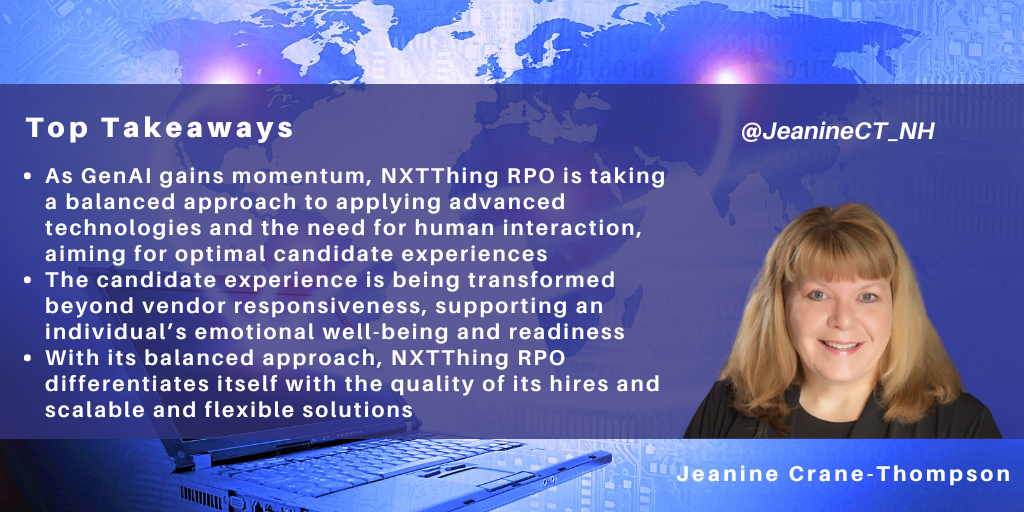
Advanced technologies such as GenAI, ML, and NLP continue gaining momentum, yielding greater efficiency and savings across all areas of talent acquisition (TA). Vendors are becoming more expert in applying these tools, improving TA outcomes and candidate experience, reducing candidate bias, identifying resources at the highest risk of flight, and predicting a candidate’s cultural fit within an organization.
Improving Candidate Experience is Key
In NelsonHall’s 2024 Next Generation RPO Market Analysis, we found that ~62% of buyers are planning recruitment transformation initiatives in the next 24 months. Improving the candidate experience and quality of hire are identified as the most critical transformational outcomes. At the same time, strategic talent insights, access to expanded talent pools, and immediate responses to candidate inquiries are likely outcomes of applying advanced technology.
According to job seekers, top factors leading to a positive candidate experience include excellent communication from a recruiter, including prompt feedback and follow-ups (55%), an easy job application process (53%), easy-to-schedule interviews (50%), and a short hiring process (43%).
According to the 2024 Employ Job Seeker Nation Report, ~26% of American workers have, at some point, interacted with a chatbot during the recruiting process. Of those, ~64% believe that the chatbot improved the process and experience, most often through quickly answering their questions (69%), quickly connecting them to helpful resources (64%), and through availability when needed, especially during non-working hours (60%). An overwhelming majority of job seekers expect to work with either a recruiter on behalf of the company (48%) or a corporate recruiter (34%) during the recruiting process.
NXTThing RPO’s Balanced Approach to Applying Technology
RPO vendor NXTThing RPO differentiates itself by the results and impacts it delivers for clients, evidenced by its clients’ quality of hire and the flexibility and scalability of its technology and recruiting solutions. The company assists clients in achieving their hiring goals and objectives by appropriately balancing human interaction and technology. NXTThing plans further integration of AI into its recruitment processes, driving efficiency and engagement. Additionally, the company will launch concierge services for new hires, providing direct support for completing onboarding, answering first-day questions, and initial cultural submersion, supporting employee well-being.
NXTThing delivers solutions leveraging innovative tools and technology where it makes sense for its clients and candidates. It educates organizations on the talent challenges surrounding their business and rebuilds their TA processes from the ground up. These insights require significant market research and data analysis at the front end, supporting its clients’ strategic hiring initiatives, such as process reengineering, generational hiring considerations, and technology infrastructure transformation.
NXTThing RPO’s balanced approach to technology application aims to provide an optimal blend of candidate interaction and responsiveness from human and artificial sources, ensuring the candidate feels wanted. The company highly values the emotional well-being of its candidates and staff, taking a Disney-like approach to providing a positive experience in the TA and employment lifecycle. Its white-glove and red-carpet approaches consider a candidate’s readiness and potential fit within the organization’s culture.
Service delivery transformation is an ongoing focus for RPO. NXTThing RPO attributes its success to its commitment to its core values, experienced recruiting team, high employee retention rate, and effective management of its TA operations. Its recruiters consult with hiring managers and develop strong client partnerships. This approach has enabled NXTThing RPO to significantly reduce time-to-fill and create a predictable TA model for its clients. The continuity of its resources and collaborative relationships are the keys to its long-term client relationships.
Investment in employees’ skills development remains a priority among RPO vendors, with an added emphasis on cross-training resources, ensuring service quality and continuity, and supporting employee retention. Additionally, upskilling strategies reflect career-long learning journeys and broadening skillsets, including data analytics, industry-specific topics, effective selling, and cross-generational recruitment methods. NXTThing RPO ensures its recruiters attend events and undertake training to keep up-to-date in their space, understanding and applying the best recruitment methods for their cross-generational target audiences. Selling a job to a candidate is critical, so recruiters must also possess practical sales skills.
Since 2020, RPO vendors have experimented with when and where best to apply technology. While this trialing has led to significant breakthroughs, such as efficiency gains, real-time candidate engagement, minimizing bias, and assessing candidate fit, it has also propagated noise in the system, leaving buyers unsure about the real benefits. As vendors continue designing optimal solutions for the new world of work, successful solutions will thoughtfully balance human and technology engagement channels.
]]>
Recruitment process outsourcing provider Advanced RPO acquired Aspirant RPO, headquartered in Pittsburgh, PA, on May 1, 2024.
Advanced RPO delivers full-cycle, project-based, custom, and high-volume RPO solutions to its clients across high-growth, mid-market, and enterprise sectors. The acquisition enriches Advanced RPO’s offering, specifically adding front-end talent acquisition capabilities such as recruitment marketing and broader talent advisory. These services ensure clients are prepared to fill current and anticipated future skills gaps resulting from retirement horizons and roles emerging from applying advanced technologies.
Aspirant RPO provides tailored recruiting solutions, including enterprise and project recruiting, talent advisory services, executive recruiting, and employer branding services; its holistic approach supports the entire talent acquisition ecosystem. The country and industry footprints of both organizations are well aligned. The acquisition will add ~80 employees to the existing ~100 Advanced RPO employees. The rebranding and integration of Aspirant RPO are scheduled for completion by Q4 2024.
The acquisition expands Advanced RPO’s service portfolio and further strengthens its market position within the chemical and manufacturing industries. NelsonHall estimates the combined RPO 2023 revenues for both organizations were $21.6m.
Aspirant RPO’s client engagement approach aligns with Advanced RPO’s high-touch, results-oriented delivery model. The complementary service offerings provided by Aspriant RPO will be valuable to client organizations as they seek to enrich their employee value propositions, revitalize employer branding campaigns, and refresh recruitment marketing strategies to attract candidates with the right talent and skills.
NelsonHall views this acquisition as a service expansion supporting Advanced RPO’s end-to-end growth journey. We anticipate synergies between the client portfolios will enable cross-selling opportunities and front-end talent acquisition advisory options for existing clients. Moving forward, Advanced RPO will be able to provide recruitment marketing, EVP, and HR advisory services, enabling internal client resources to focus on strategic initiatives that deliver longer-term value.
Aspirant RPO is Advanced RPO’s first acquisition. Yet, the company states that it has both organic and inorganic growth strategies, indicating that it may look to further acquisitions in the future.
Several other RPO vendors have made similar acquisitions to extend their capabilities, including:
- Kelly Services acquired Motion Recruitment Partners, LLC (MRP) in May 2024
- Hudson RPO acquired Executive Solutions, a Dubai-based talent solutions company, in March 2024 and Hudson Global Resources, a Singapore-based RPO provider, in November 2023
- Job Mobz acquired Golden Hive RPO, a Sacramento, CA-based RPO provider, in December 2023.
Service delivery transformation is ongoing as RPO vendors examine all aspects of their operating models and offerings, and buyers focus on modular services to support prioritized hiring campaigns and staff augmentation. Organizations will leverage broader and strategic services for infrastructure modernization and recruiting process optimization. Additionally, consulting will remain in demand as organizations seek DEI, SWP, change leadership, and technology consulting services to support near-term and longer-term transformational and workforce planning strategies.
To support the rebound in hiring volumes anticipated in H2 2024 and the need for broader HR and technology expertise, NelsonHall expects more acquisitions in the RPO market in the year ahead.
]]>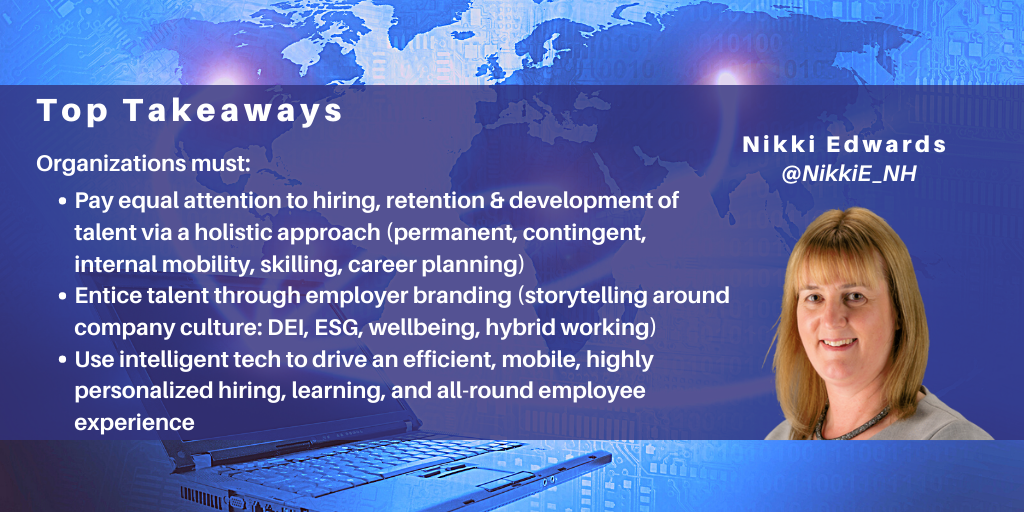
Here I look at the major trends for the year ahead in two key areas of HR: recruitment and learning services.
Recruitment Trends
Talent Acquisition (TA) challenges were already complex in the pre-pandemic period, with an aging workforce population, shortage of digital talent, rapid evolution of technology, Brexit, legal changes, and more. The pandemic added another layer of complexity in 2020: the rapid shift to digital hiring/onboarding (with some sectors seeing rapid upticks in activity), non-digital skills shortages, working from home and keeping workers safe and well. While expectations for 2021 focused on digital, hybrid working with a highly-distributed workforce, the Great Resignation presented unforeseen challenges, with knock-on consequences, requiring organizations to take a different approach to the future of work.
Organizations struggle to find talent in a highly-squeezed market, as tried and trusted methodologies no longer work. More are reaching out to vendors for support as they become desperate to attract candidates while juggling increased turnover levels of existing employees. Vendors are evolving their TA solutions in line with advancing TA trends. The hot topics for 2022 will be:
A total talent/holistic approach to hiring
Organizations will act upon their 2021 intentions, as sought-after talent is no longer guaranteed from traditional full-time/permanent channels, requiring a contingent or internal mobility channel approach. So, all organizational functions must work collaboratively to proactively strategize their 2022 talent plans via a strategic workforce planning (SWP) approach, using enabling technologies to aid the process. While some urgent talent needs may require a quick fix, this reactivity is unsustainable long-term. An increased focus on internal talent mobility will reduce the risks of unnecessary employee turnover. Organizations must also plan their salary/contractor rate positioning (avoiding neglectful over-inflation of rates) to prevent future problems around pay inequities across the workforce.
Back-to-basics recruitment
Companies are competing for talent from shrinking talent pools, as the sansdemic (decreasing working-age population) and the Great Resignation dominate the 2022 market. The most in-demand TA services will be employer branding and associated services contributing to organizations’ brands. Businesses will work hard to promote their company cultures to be future-of-work fit for their audiences, across all talent channels. Priority is on promoting diversity, equity, inclusion, and belonging (DEIB), work flexibility, safety/wellbeing, career longevity, and environmental, social, and corporate governance (ESG) issues.
In one of the most candidate-led markets in years, tried and trusted recruitment methods are becoming less effective, yielding fewer candidates. While pandemic-induced travel restrictions impact talent mobility on the one hand, on the other, more significant opportunities exist to engage remote talent globally. So, organizations must expand their repertoire of initiatives to reach candidates: international hackathon events to find future digitally-skilled talent, leveraging previously untapped audiences (career returners or those launching second careers). Companies failing to focus on these basics will lose out on vital talent.
Building talent by upskilling and reskilling organizations’ workers
Traditionally, the focus was on building in-demand digital skills and reskilling workers whose roles were being automated. Organizations must now expand the remit to offset the broader talent challenges associated with employee churn.
Essentially, TA and learning will work in greater unison. Corporate functions must plan how talent will be managed beyond initial recruitment/onboarding to drive ongoing employee engagement and development, to encourage longevity of service. A training course here and there or a HiPo scheme for a select few are no longer fit-for-purpose in their traditional formats. Long-term career mapping and initiatives to put newly-learned skills into immediate practice for all workers will be required, or workers will seek to progress their careers elsewhere. Core to this experience is using intelligent, AI-driven tech, feeding personalized content, enabling a self-service, pull approach to skilling, upskilling, and reskilling.
Next-generation platforms/tools
Hiring quality candidates at speed while driving a highly-consumerized experience will remain a priority (although hiring speed success is likely impacted by talent availability). Candidates will expect a predominantly digital hiring experience to meet the needs of a workforce seeking flexibility and being less focused on having a physical workplace presence.
Employees will expect to use intelligent tech, underpinned by sophisticated RPA, AI, and ML, via a single platform interface to drive a highly tailored and personalized day-to-day work experience (feeding relevant content to them to maximize role efficiency). Hence, there is also a greater shift to a microservices/low-code/no-code architecture as a standard. The appetite for deep data and predictive/prescriptive analytics will grow, as organizations and their workers seek insights to help eke out extra competitive edge in all areas of talent. The use of digital agents and voice-enabled technology to personalize the tech experience will be a focus in 2022.
Learning Trends
In 2021, learning focused on building out the digital foundations initiated in response to the 2020 pandemic. Hence, the criticality of using the most appropriate technology and tools to drive a digital learning experience emerged. It is now generally accepted that a predominantly digital learning approach is the way forward, focused on skilling for the future of work.
Events such as the Great Resignation of 2021, inadvertently fueling the talent shortage, have turned attention to employee engagement, retention, and development to offset employee turnover. Hence, in 2022, learning will see a revitalized focus and achieve a higher priority within organizations to curb TA challenges (as part of the holistic/total talent approach to attaining the skills needed). Learning vendors continue to develop their services and technology apace to support businesses in meeting their workforce skilling needs. Hot topics for 2022 will include:
Tailored content for skilling
Learning vendors will continue to curate content (where there is an abundance of ready-made material available on generic skills) and create content (where organizations need tailored content for a product or specialty compliance reasons). Subjects such as digital skills (from basic to advanced, niche, certified skillsets) and future of work skills (remote leadership, maintaining wellbeing), commonplace since 2020, will continue apace.
With many organizations focusing on raising their corporate profiles to attract talent, there will be demand for DEIB and ESG awareness training, living the company culture when workforces are remote, and managing employee performance/career conversations. Enhancing skills training focused on the digital world of work will include digital selling (without face-to-face engagement).
Learning tech/tools
In 2022, the technology and tools focus will deliver experiential learning, taking advantage of RPA, AI, and ML developments, driving content suited to individual learners' preferences and needs. More organizations will seek advice on replacing or augmenting their existing learning systems with LMS/LXP and other specialty platforms to ensure learning is engaging and tailored to encourage self-service/pull learning in the flow of work. Notably, Microsoft Viva will make an impact on the LXP market. Driving learner engagement will start at the candidate level via digital onboarding (supporting pre-boarding learning activities to give new employees a head start and the opportunity to reach productivity sooner).
Next-generation platforms delivering digital internships, graduate programs, academies, and certification programs will be sought to skill, upskill, and reskill a more distributed workforce, to engage and retain them long-term. The use of events platforms will also increase alongside. A mobile-first/appified and microlearning approach will dominate, enabling learning to take place in small chunks across all devices, fitting in with learners’ busy lives. For companies keen to create content internally or manage curated content, the uptake of rapid authoring tech and content library subscriptions will increase. Organizations will seek more learner-specific data/analytics to measure the success of their learning programs as the competition for skilled talent intensifies.
Next-generation modalities
The emphasis on experiential learning will drive the demand for engaging modalities, such as video, animation, gamification, serious games, and simulation. There will be re-energized demand for VR, augmented reality (AR), and the metaverse, as the technology becomes less expensive. An emerging area is haptic technology enhancing kinesthetic learning.
Other learning services
Demand for consulting services will continue, covering digitalization of learning (including tech/tools and learning content advice), reskilling/upskilling, and driving learner engagement (as retention of talent becomes a priority to avoid unnecessary turnover). Administrative services will continue to focus on systems administration and the sourcing of third-party suppliers, as more organizations decide to outsource such tasks.
]]>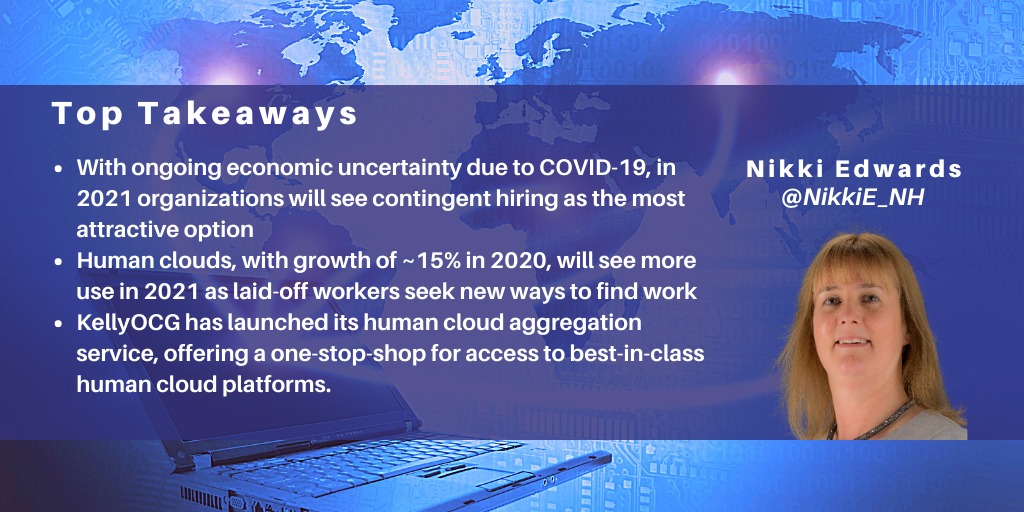
Quarterly financial reports for 2020 (April onwards) from recruitment organizations show that in a COVID-19 world, temporary hiring is more resilient than permanent hiring, faring on average about 10-30% better (albeit both types of hiring are seeing negative growth overall). Meanwhile, gig work has increased on average 10-15%, over the same period. These figures are not surprising as organizations undertake recruitment that minimizes labor cost risk. And, in 2021, with the economic situation likely to be the same as 2020, organizations will want to maintain flexibility with their workforce, making contingent hiring the most attractive option.
With a multigenerational workforce demanding more flexible working arrangements (avoiding the 9 to 5, choosing working hours, characterized by freelance or gig work), now is an ideal time for organizations to embrace a holistic (total talent) approach to talent acquisition. Organizations have also demonstrated their resilience in embracing technology/tools to enable remote working. So, now is the time for organizations to combine the two: using additional technological channels to find the flexible skilled workers they need to get tasks done, while minimizing labor cost risk in an economically challenging market.
Human clouds, where task-specific jobs, projects or gigs are carried out on demand from any location, using an online/digital platform, have seen a growth of ~15% in 2020 over 2019. And they could see a further uptick in use in 2021 as workers laid off due to the COVID-19 pandemic seek new ways to find work.
Challenges in determining the most suitable human clouds
At first glance, there are potential challenges in determining the most suitable human clouds to use, when:
- There is a choice of at least 1,800 online recruitment platforms/human clouds (KellyOCG, 2020)
- Some advertise a broad range of skills, while others are highly niche. How do you know which ones are most suitable for hiring specific skillsets?
- There are choices on human cloud/platform types: organizations would likely seek candidates by entering a direct legal relationship with an individual worker, using an online marketplace platform such as Toptal. But another option is to use a crowdsourcing platform, where several workers bid for, then independently work on, specific elements/constituent parts of a project. 99designs is an example of such a platform. In another example, restaurants refocusing their business for online delivery may use a service platform such as uber eats to seek drivers to deliver takeaway food to the public
- These marketplaces operate in their own environment, with their unique ecosystem and end-to-end process
- For procurement, it is an expensive way of getting labor (by paying separately for resources on different platforms).
One vendor that has addressed these potential challenges is KellyOCG.
KellyOCG’s one-stop-shop solution
KellyOCG has recently launched its human cloud aggregation service, offering a one-stop-shop for access to best-in-class human cloud platforms. Initially offered as part of its MSP/CWS offering, the service fills the gap in its holistic/total talent acquisition offering. The service combines human support underpinned by technology.
The Kelly Human Cloud technology (co-developed with Avature) automates and consolidates the process steps and harmonizes the profile information from each human cloud (with their unique profile formats). Some platforms involve going through a mini RFX process, where freelancers bid on the work to be done. Other platforms have a white glove hands-on approach, with a consultant that understands the requirements and finds the talent. The platform links to the organization’s VMS, enabling the hiring manager to review worker information and manage the project via the most appropriate human cloud. The system integration allows an organization to use existing invoicing and time-sheeting functionality within the VMS without re-inventing the wheel externally.
Once a new organization comes on board, it signs a client-specific contract or an addendum to a master services agreement, allowing for very easy onboarding with minimal administration. This saves the organization from needing to negotiate all the platforms separately. The organization determines whether a human cloud environment is suitable to get the work task done. KellyOCG liaises with the hiring manger to determine ground rules around using human clouds, then configures the decision-tree functionality within an organization’s VMS to determine the best hiring option. If the work can be delivered remotely (with talent sitting anywhere in the world), human clouds can work, though obviously they are not suitable for organizations that want the physical presence of a worker in an office environment.
One of KellyOCG’s clients needed to undertake quality control on 50 billboards it had set up across 50 airport locations. After posting a requirement on a platform, the client identified candidates to undertake the work of going to an airport, taking a picture of the billboard, and uploading it to enable the client to check on the quality of each billboard. The candidates received payment for the work done.
After initially reviewing eight human cloud platforms, KellyOCG settled on an initial five with which to launch the aggregation service: 99designs (leading in the creative space), BTG (Kelly major stake), The Mom Project (diversity), Toptal, and Freelancer.com. The core five cover most of the skillsets hired within its clients’ existing hiring programs. KellyOCG plans to expand the human cloud aggregation service, adding more human clouds over time.
The need to use remote talent will endure
In addition to the ongoing budgetary concerns about the cost of labor in an uncertain economic market, other restrictions remain in place, making remote talent an attractive proposition. Many countries are not processing visa applications, so workers cannot travel internationally. The second wave of COVID-19 is already well-established, potentially forcing further lockdowns at a local or country level well into 2021. Embracing human clouds should not be concerned with the “if” but rather the “when”.
While KellyOCG does not yet have any data/analytics around the usage or success of leveraging the human clouds in its aggregation service, there are some statistics that serve as a starting point. For example:
- 99designs have 20K designers working on the platform every month, and a new design is created every two seconds, with 97m designs created overall
- In 2019, Freelancer.com posted 1.9m projects
- In 2020/21, The Mom Project expects 10k projects to be posted on the site.
Undoubtedly, the number of candidates registering on human cloud platforms will increase, as more traditional methods of hiring requiring in-person interviews are stalled. Companies need to act to capture these work-ready candidates.
]]>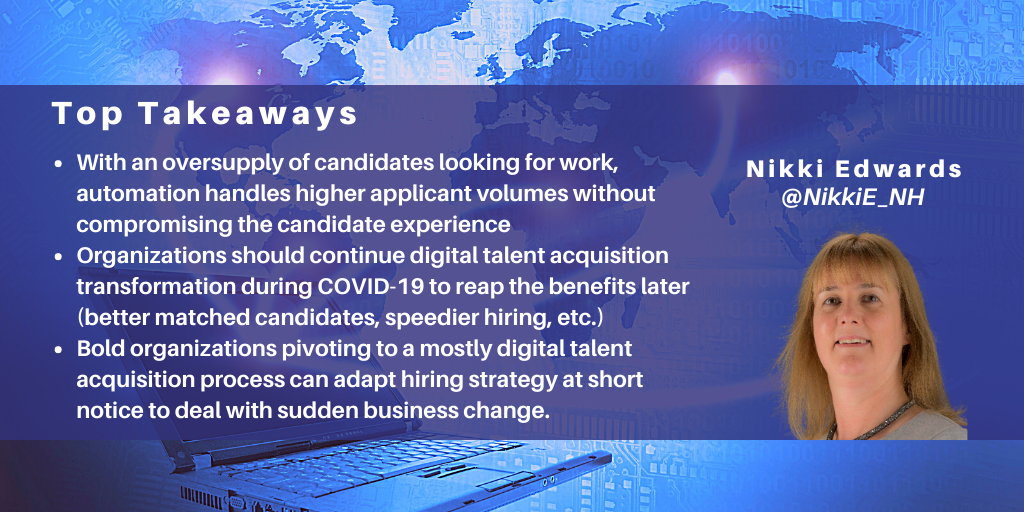
Everyone speculates as to what the long-term world of work could look like as we head into the second half of 2020 and beyond. But the reality is that we don’t really know how things will pan out. While organizations might be preparing for an uptick in hiring activity behind the scenes, the biggest challenges are the ongoing uncertainty around the future of work, and even survival from week to week.
Organizations have demonstrated resilience and agility in adapting to tech-enabled, remote, and socially-distanced operating models, often being surprised by the outcomes this has brought, notably business continuity with minimal interruptions. To continue talent acquisition (TA) activities, organizations have embraced tech and tools to aid remote interviewing, electronic signatures for documents, and remote onboarding.
However, organizations that fail to embrace such digital change, will leave themselves inflexible to sudden changes in business requirements, putting long-term survival in jeopardy.
Here, I look at three of Korn Ferry’s clients at different stages of digital TA transformation, to measure the impact of that journey on their hiring activity, as business priorities were turned on their heads.
Organizations embracing digital talent acquisition can pivot at short notice
A long-standing consumer products client, with 70% of its workforce sitting in high-volume categories (production, retail, etc.), approached Korn Ferry in 2017 to support its shift to a more digitalized approach to hiring. Using its six pillars methodology, Korn Ferry focused the client on identifying the hiring challenges they were trying to resolve. It recommended a third-party tech stack as well as proprietary tech to best enable the client’s objectives: scalability for seasonal and geographical expansion ramp-ups and ramp-downs being its priority (with the technology designed to handle candidate volume - 15,000 annual hires - at the top of the funnel).
While the funnel would normally be slow and inactive, with Korn Ferry seeking out talent through active campaign work, 2020 has seen that flipped on its head. A spike in unemployed people looking for work has transformed the client’s talent funnel to being very full and active, yet the client has absorbed the funnel ramp-up with no drop-off in service due to the scalable technology already put in place. The client can deliver a good candidate experience because the automation handles the sheer volume of applicants and screens them out if they are not suitably skilled. Having the digital capability to scale has clearly enabled this organization to pivot to the new circumstances of an oversupply of candidates.
A financial services client, hiring 30K heads annually, had fragmented, inefficient, and manual hiring processes. It was looking to digitally transform its talent acquisition function to increase efficiency and improve the candidate experience. Following a tech stack audit, it was advised to use a combination of Korn Ferry’s proprietary technology and a few select external providers. Korn Ferry Recruit (KFR) with its AI-sourcing capability would be suitable for niche roles (10K annual hires), while KFR’s Nimble platform with its chatbot and short-form assessments would be suitable for high-volume recruitment (20K annual hires). A proposed trial of an internal mobility platform was a feature of the tech stack. Many organizations keep scant records of employee skillsets. However, the internal mobility platform takes non-confidential employee details from basic HRIS records and augments them with in-depth public domain information available externally. The enhanced information acquired by Korn Ferry enables internal talent with specific skills to be identified and deployed elsewhere.
As March 2020 resulted in the immediate cessation of hiring in its retail setting due to the pandemic, there was an immediate need to redeploy employees into other roles within the business. While the recommended platforms/trial had not been implemented at this stage, there were strong indications that continuing with its planned TA transformation during COVID-19, would reap hiring benefits post-COVID-19 or in subsequent lockdowns. Benefits would include improved Time to Fill (when ramping-up numbers to meet pre-COVID BAU staffing levels), Interview to Hire, and Quality of hire measures (due to better AI matching of candidates), or easier redeployment of workers elsewhere if retail premises needed to close again.
It’s not too late to embrace digital TA and reap the benefits
The ongoing uncertainty for another of Korn Ferry’s clients (in the hospitality sector) will linger until a Government decision is made on whether to permit the mass gathering of people in 2020. And the window of opportunity for hiring is drawing ever tighter (with the final client decision for a “go” or “no go” hiring situation due in July). However, that has not prevented the client from preparing its TA strategy for this year.
The client would normally launch multiple in-person, recruiter-intensive hiring events, over five months (as it did in 2019) to find the 4.5K part-time talent needed for the Autumn season: a process that from year-to-year rarely sees the same talent apply. However, by March 2020, it was clear this talent campaign was not going to happen, so the client approached Korn Ferry for support. Korn Ferry suggested going 100% digital for its 2020 campaign – a dramatic pivot for the client, but one which would enable an instant 60% reduction in campaign duration – great when leaving the decision whether to hire until the eleventh hour!
Korn Ferry has deployed the Breezy HR platform and designed a single workflow (enabling a single application process) for six separate franchise companies that come under the remit of the client (rather than requiring six separate application processes), much improving the candidate experience. The manager’s decision to hire specific candidates is the only manual phase, with all other process steps being automated. If hiring does not go ahead, the worst-case scenario for the client is the cost associated with the consulting work undertaken in standing up the project. There will be no costs associated with the technology.
When decisions must go to the wire, with potentially 75 heads to be hired daily for 60 days, having a digital TA process clearly has its advantages. Whether the client forges ahead with hiring or reluctantly admits defeat for this year, it will be interesting to see if the digital TA set-up has changed their outlook on future recruitment for the better.
A digital TA transformation approach helps organizations embrace the future of work
Embracing a digitally-enabled hiring process does not mean sacrificing the high-touch approach. It is about achieving the right balance between technology and human interaction. Some digitalization of the TA process enables automation of mundane tasks and speeds up the hiring process, clearly giving competitive advantage to organizations. Driven by events in the first half of 2020, the technology deployed by these clients has enabled them to adapt to new circumstances when they least expected it. These case studies show how a digital approach to TA can take organizations to a new level of business agility that can help them to adapt to unforeseen circumstances at the flick of a switch. A digital TA transformation approach is highly recommended, especially when the future holds so many unknowns. Failure to embrace digital TA processes in 2020 will put those organizations at increasing disadvantage, making it more difficult for them to catch up with those organizations who have embraced digital transformation and are enjoying the benefits of being business agile.
]]>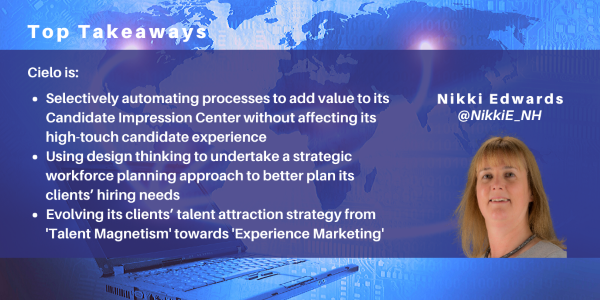
The pace of change in RPO and contingent worker outsourcing has been unprecedented in recent years due to technological advancements and the range of services expected by buyside organizations. Cielo recently organized a customer and analyst day to explore what talent acquisition (TA) might look like in the next five years.
Speaking with several of Cielo’s clients, they comment on Cielo’s enthusiasm to question the status quo and ask how things can be done better, and on its keenness to continuously improve and be future-fit while maintaining its core values.
Automation must complement high-touch service
Clients cite Cielo’s “WE BECOME YOU” mantra as a feature of its RPO service. They value the Candidate Impression Center and Bridge pre-employment service, established in 2010 to address pain points in the recruitment process (such as a lack of contact with candidates once they have applied for a job, and post-job offer before the employment start date). Given the current focus on candidate experience, remaining high-touch is key. With Cielo’s Candidate Impression Center, a chatbot now provides a response to the top 100 FAQs to save agents’ time, with humans doing more meaningful and highly personalized candidate-care work.
The RPO journey is becoming a Total Talent expedition
Cielo aims to adopt a partnership approach with clients, taking them on a journey of improving both efficiency and effectiveness in their recruitment processes. Enhancements to the service have included SkyRecruit, reporting and analytics (SkyAnalytics), Employer Branding (EB), and most recently consultancy services in areas such as TA strategy, tech advisory, marketing, and diversity and inclusion. The shortage of talent in many skills areas has spurred Cielo to look at alternative sources of talent such as contingent workers and developing existing employees to plug supply gaps, taking more of a total talent acquisition (TTA) approach.
Cielo is now taking the partnership approach to the next level with its Client Success Program. Using Cielo’s Talent Acquisition Maturity Model, clients are presented with a scorecard to determine their position on the RPO/Total Talent journey at various points through the relationship. Using design thinking, Cielo undertakes a more strategic workforce planning (SWP) approach to better plan its clients’ hiring needs to help them improve their talent acquisition maturity.
Next-generation delivery – “Certified to Serve”
Cielo posits that delivery excellence requires more than expertise in sourcing talent and industry sector knowledge. In its “Certified to Serve” initiative, Cielo’s talent advisers are required to be knowledgeable in hiring process definitions, operating principles, talent options, payrolling/invoicing, plus information specific to the client. Those with more advanced skills can advise on SWP.
Enabled by technology or driven by technology… a matter of preference
Cielo has seen early traction with its more automated High Volume RPO (HVRPO) platform launched in 2018. Several clients are using HVRPO in conjunction with Cielo’s SkyRecruit platform, typically hiring in high volume for niche/specialized roles. Examples include:
- A pharma that has made 4,000 hires through the HVRPO platform and has seen an 11% decrease in time to accept an offer
- A food service company that has made 5,000 hires and saved 1.5 hours of hiring manager’s recruitment time per hire through tech-enabled screening.
While at present Cielo’s clients mainly leverage recruitment technology as an enabler with limited automation (confined to processes that are already successfully automated in the wider market, such as website apply, interview scheduling, etc.), Cielo anticipates that in future more of its clients will leverage Cielo’s HVRPO platform (with programmatic advertising, mobile apply and assessments, automated matching, interview scheduling, and offers/onboarding) to drive the hiring process.
The “Experience Marketing” experience
Successful hiring requires a talent attraction strategy (making use of EB services) along with candidate sourcing. Cielo’s clients have embraced what Cielo calls Talent Magnetism (recognizing the importance of websites, campaigns, social media, and EVP in the TA process). The next phase is Experience Marketing (focused on EB and communications), which tailors marketing and communications to the stakeholder (the client, hiring manager, candidate, and employee team member).
What’s next?
Cielo has reimagined and redefined its RPO offering, but what will be next? With the global skills shortage worsening, the blurring of the lines between permanent and contingent hiring to secure talent to deliver a business outcome may no longer be enough. It is already apparent, with the accelerating sophistication of technology/tools, that the current workforce is not sufficiently digitally capable to embrace the tech-driven workplace of the future.
If the required talent cannot be bought or borrowed, then it will need to be built. Organizations have the choice to seek expert help from both recruitment and learning outsourcing vendors, but as seen with TTA, why would you leverage multiple providers to source talent when one provider could be more efficient, effective and cheaper (especially when the available talent plays in both pools)? Savvy RPO, MSP and TTA vendors could become Talent Management experts, blurring the lines between talent acquisition and talent development. Cielo aims to become a “Talent Outcomes and Talent Experience” company. Does that mean it will further reimagine and redefine its portfolio and become a Talent Management vendor?
]]>
I recently attended Korn Ferry’s RPO Client Advisory Forum, which was all about talent management. The theme was ‘unplugged’ and featured frank discussions about the RPO industry, including the challenges faced by the clients and service providers who attended from every region.
Beyond RPO, Korn Ferry offers many complementary talent management services, including those from its Organizational Consulting practice. One of the emerging talent trends of 2019 presented by Byrne Mulrooney, CEO, Korn Ferry RPO, Professional Search and Products, is rethinking performance management, and here, discussion topics included: engaging talent to create solutions that transform, helping people to see brilliantly, and building value through people.
Korn Ferry’s goal is to be the preeminent organizational consultancy, specifically regarding talent and the importance of articulating the right relationships.
Partnering with Qualtrics
As a step towards its goal, Korn Ferry and Qualtrics partnered earlier this year to build a global delivery and advisory service to improve employee experience. The partnership combines Korn Ferry’s Organizational Consulting services with Qualtrics’ Experience Management (XM) platform, to be applied throughout the employee lifecycle.
By joining the Qualtrics Partner Network (QPN), Korn Ferry is going to market by combining its organizational methodologies and expertise with Qualtrics’ XM platform to provide organizations with the expertise and technology they need to achieve breakthrough results at every stage of the employee lifecycle.
Korn Ferry has standardized on Qualtrics as its technology platform and will become a global strategic consulting partner for Qualtrics, providing end-to-end delivery and advisory services for clients globally. Through the QPN, Korn Ferry will also offer consulting and advisory services to Qualtrics EmployeeXM customers in more than 50 countries globally.
The partnership will enable Korn Ferry to go to market with offerings that include its platform, employee engagement and culture surveys, 360-degree reviews, and social listening tools, to enable employers to better manage talent and the associated talent management systems.
Impact for RPO buyers
Per NelsonHall’s recent RPO market analysis, including interviews with end-user buyside clients, one of the top drivers for outsourcing recruitment today is to gain better access to expertise, insights, technologies and tools. This is an area Korn Ferry has excelled in according to client satisfaction data. Recent interviews with Korn Ferry clients conducted by NelsonHall revealed high client satisfaction scores for their partnership capabilities in particular. And, having now attended three events with Korn Ferry RPO providers and buyers, my observation is that Korn Ferry does have a very strong relationship with its clients.
In terms of what will be driving buyers to outsource recruitment in the future, the research indicates that this will include requirements for talent management services that are complementary to RPO, such as internal development of existing employees through upskilling and reskilling.
]]>
Last week I attended PeopleScout’s annual client NEXT Talent Summit 2019. In the keynote address, President Taryn Owen noted that this event marked one year since its acquisition of TMP to strengthen its global RPO and talent advisory capabilities. TMP, which operated in the U.K. under the brand name TMP Worldwide, provides employer branding, recruitment marketing, and RPO services through its Yocto brand. The acquisition expanded PeopleScout’s global RPO capabilities and EMEA client base, and its London office became PeopleScout’s EMEA headquarters. TMP expanded PeopleScout’s talent advisory offering by adding services such as employer branding, recruitment marketing, assessment services and talent acquisition strategy.
PeopleScout has also been growing organically, adding over 45 RPO contracts in 2018, and now has over 215 RPO clients with over 300k annual hires. In addition, there were around two dozen contract extensions. PeopleScout continues to be the largest RPO provider in terms of revenues in North America and they have continued to grow globally, across EMEA, APAC and LATAM. Half of PeopleScout’s employees are now based outside of the U.S.
Taryn Owen stated that a major priority for PeopleScout is its Affinix technology to enable a better user experience for candidates. Affinix is built on Amazon Web Services (AWS) cloud infrastructure, integrates with all ATS and VMS systems, and has a single sign-on. Its capabilities include:
- Digital and social recruiting, including the creation of job ads, job descriptions and career portals
- Artificial intelligence, including for immediate sourcing of passive and active candidates when a job requisition is opened
- ‘Mobile first’ platform for both the candidate and the hiring manager throughout the application, scheduling and screening process
- Video interviews and digital assessments to reduce time to hire using data analytics and machine learning to identify and rank the best candidates to communicate with hiring managers faster
- Predictive analytics and machine learning throughout the hiring process to better understand top talent behaviors and predict factors such as cultural fit, willingness to change companies, and future tenure potential.
One of the presentations by Andrew Wilkinson, PeopleScout’s Group Managing Director of Europe and APAC, was on creating a compelling brand experience across the employer lifecycle. Per NelsonHall’s RPO Market Analysis published last week, employer branding has elevated in importance as the global talent shortage has worsened. And in recent interviews with PeopleScout RPO clients, this was seen as an area where PeopleScout is excelling, as these two examples indicate:
- For a U.K. grocery chain, PeopleScout created a campaign featuring videos of a diverse group of people sharing stories about managers who inspired them. The video was viewed 484k times with positive feedback, resulting in exceeding the client’s goal of hiring 3k people for a new type of role
- For Virgin Media, PeopleScout focused on increasing employee referrals, updating its referrals website to elevate employer branding, and helped to communicate the Employee Value Proposition to current employees so they could identify the kind of people Virgin Media wants to hire. Within one year, referrals increased external hiring by 10% to 25%, employee participation increased to 40%, quality of hires increased, and Virgin Media saved $9k per hire on average.
Having attended these events four years in a row, I’ve observed that PeopleScout has a very strong and collaborative relationship with its clients, reinforced by achieving high customer satisfaction marks for quality of partnership in our most recent RPO NEAT vendor evaluation.
]]>
ADP held its 26th annual Meeting of the Minds (MOTM) client conference recently, celebrating its 70 years in business. ADP is helping change the way employees work by continuously introducing new and enhanced products and services, and here I focus on three key areas: mobile, how pay is accessed, and recruiting.
ADP Mobile: growth & new developments
ADP has 20 million registered mobile users, with an average growth rate of 500,000 new users per month. Users use the mobile app on average ~10 times per month. There are 413,000 clients globally, with 20m notifications pushed to the mobile app per month, and in Google Pay it has a satisfaction rating of 88% (4.4 out of 5) with 500k 5-star ratings. ADP Mobile is available in 46 countries, in 27 languages.
ADP Mobile usage includes the ability to view and print pay and W2 statements and categorized pay reports, set up direct deposit of checks, view balances, and clock in and out (which is the most widely used feature).
Recently released features include:
- ADP Watch was released in November 2018, and has had 688k app sessions. Notifications can be received on a smart watch, and soon workers will have the ability to punch in and out with their watch
- Siri shortcuts, including ‘show me my pay and benefits’
- Managing notifications by grouping them however you would like
- Mobile federated single sign-on for users to use their own company credentials, so they don’t have to remember new login information
- Employees and manager dashboards to access lists of responsibilities of all the things they need to do. 95k policy approvals were made within 2 weeks of release
- Direct deposit check image capture – the ability to take a picture of your check to make a deposit so you don’t have to go to a bank
- Profile updating, including view/edit business title, preferred name, pay information
- Ability to do group texting to your team
- Wage garnishments and receipt of email notifications, reducing call center calls by 50%
- Viewing benefits, opening enrollment, updating life events, and uploading documents pertaining to your benefits
- Paycard self-enrollment and the ability to transfer money between cards
- Employee scheduling and the ability to swap work shifts via the requestor to the receiver and approval by the manager
- Via ADP DataCloud managers can obtain absence rate information, pin-point where problems are, and act right away by sending an email with a visual depicting data to be discussed.
Future enhancements will include:
- Notification where OT is highest
- Pay on ADP Watch
- Notifications sent to workers forgetting to clock in
- Chat feature, beginning with wage garnishments and benefits
- Learning, including courses you need to take
- Electronic signatures.
In sum, mobile is a game changer as it improves employee satisfaction via ease of use. As evidence, I sat in on several client presentations of ADP products, e.g. Vantage, and three clients specifically stated that adoption of mobile was much easier than deployment of equivalent desktop applications. The clients said that initial adoption was ~70%, 87% and 90% respectively.
New mobile features are released every three weeks by ADP.
Accessing pay
How workers want to get paid is changing, including lower income workers who may require more immediate access to pay. Thus, ADP is offering quicker access and more flexible choices to receive wages.
In May 2018, ADP Launched Wisely Pay following its acquisition of Global Cash Card. Wisely Pay provides individuals with multiple ways to receive, spend and manage money, including fully electronic options such as peer-to-peer transfers, instant pay, and mobile digital wallets by Apple Pay, Samsung Pay, and Android Pay.
In addition to Wisely Pay, employees can receive pay via options including direct deposit, Venmo digital wallet, Amazon, and Walmart money card. Employees can watch a short video to view the different options and benefits of each. Employees can split their choices of how they want to be paid across all options available with any percentage split. Employees can also track spending patterns and receive alerts on how much they spend and save. Employees can also have early access to pay for the current pay period. If they are short on available money to pay a bill, they can click on the amount needed from their current pay period and deposit into their account. Emergency funds can also be set up.
ADP recruiting (RPO)
This will be a big growth area for both standalone RPO clients and multi-process HR clients, as currently ~10% of its newest clients are existing ADP clients and there are thousands of current clients that can be targeted. A couple of immediate areas that will benefit clients are:
- Use of ADP DataCloud, including via mobile, to obtain insights on flight risks to retain talent
- Candidate chat. Since I have been involved in recruiting for ~25 years, candidates consistently complain about the time and difficulty to submit for jobs and then not hearing back on status, with a historic ~70% dissatisfaction rate across all companies/industries. Candidate chat will allow candidates to answer a few basic questions via chat that contain knockout questions; and if the candidate is qualified, they will receive immediate feedback and be able to continue job submission.
As I wrote this blog, I happened to see ADP’s latest TV ad, with a voiceover that says ‘At ADP, we’re designing a better way to work so you can achieve what you’re working for’, which is a neat summary of the ADP approach. Competitors will be sure to follow suit with similar initiatives, but by continuously innovating and improving its products and services, ADP is laying the groundwork for its next 70 years in business.
]]>
Earlier this month, Allegis Global Solutions (AGS) launched the QUANTUM Platform™ to the U.S. market. QUANTUM is a workforce acquisition (WA) framework comprising a total talent strategy, a sourcing methodology, and a technology platform all in one. 18 months in the making, the idea was initiated about a decade ago, as discussions began around the roadblocks associated with having separate RPO and MSP programs and data/information stored in disparate systems. While WA programs and tech/tools ecosystems have evolved significantly since 2008, throw in the worsening global skills shortage and it becomes blatantly clear that a new approach to acquiring talent was badly needed…. hence QUANTUM, which consists of:
- QUANTUM Strategy: to help clients fill jobs and get work completed in the most efficient/effective way
- QUANTUM Methodology: AGS’ proprietary workforce acquisition methodology, providing clients with a single-entry point to all types of workers (permanent, temps, contractors, freelancers/gig workers, and consultants) via the QUANTUM Platform, with advisory support from AGS in how to best go about leveraging those workers to get work done
- QUANTUM Platform: sits across all other technology platforms and uses AI/ML, underpinned by its analytics, to bring together all types of talent from other sources into one place.
Here, I take a pragmatic view of QUANTUM based on what is generally happening in the marketplace around WA frameworks and my recent demo of the QUANTUM platform. The strategy of “getting work done” is one of the hottest talking points for vendors at contingent workforce events at present, with a few of the key vendors established in the MSP and RPO space currently developing a WA framework to address the issues described above.
The associated methodologies applied to help clients get work done are unique to each vendor: a reflection of the vendors’ history, their strengths/expertise, and the challenges faced by/needs of their clients from a geographic, industry, size, skills, and outsourcing maturity perspective. The methodologies aim to give clients a number of options for how to get the work done based on insights from the vendors’ unique data, associated analytics (via a platform), and the vendors’ internal experts (consulting).
QUANTUM Platform
Talent platforms like QUANTUM Platform enable a hiring manager (HM) view, a supplier view, and the program office view. When each new talent platform emerges, though, there is an expectation that it will leverage some of the latest technology features/functionality available. QUANTUM Platform does not disappoint from that perspective. Features include:
- Ability for a HM to search for talent by carrying out a people search (like window shopping) or load in a job description
- Elastic search (enhanced AI matching and stack ranking) by matching candidate skills with those skills necessary to perform the open positions. Elastic search also allows HMs to view stack ranked candidates based on skills and experiences. Candidates are sourced from different talent clouds:
- Supplier contractor talent cloud
- Redeployed contractors (who have come out of an assignment ready to go elsewhere)
- Client-sourced talent cloud (retirees, alumni, veterans, interns, etc.)
- Freelancer talent cloud
- Service provider consultants (SOW and service procurement)
- Full-time candidates (from an ATS, silver/bronze candidates)
- Existing employees (full-time employees who can assist on project work, who are searching for a new internal career opportunity)
- Ability for AGS to save time at the face-to-face intake meeting (with automated search results enabling a slate of talent to be in front of the HM the same day, at least a 50% reduction over the standard process)
- Ability to fill jobs more quickly (trials to date showing a 65% reduction in time to fill on average). 50% of roles have been filled with talent sourced from the QUANTUM Platform, 50% have eventually gone out to competitive bid
- Underpinned by sophisticated data/analytics:
- For example, QUANTUM’s data might show that a local software developer has an average time to fill of 34 days, but there is a qualified freelancer in another market who has just become available and can start immediately. AGS can leverage that freelancer and alert the HM to engage the person immediately (the freelancer being a resource that the HM would never even have considered previously)
- QUANTUM’s market data (comprising supply and demand data, predictive analytics about location, job market, competitor intelligence) is used to provide a hiring scale to indicate hiring difficulty: focusing on potential candidates, positions currently posted and average post duration. If a particular market has a higher score (more difficult to fill), then AGS consults with the HM to see if they can adjust the skills (to make it easier to get more candidates), or choose a different recruitment channel (use a retiree rather than a traditional temporary worker, etc.) or a different location/relocation
- Ratings for candidates (given by HMs for work done):
- Creating better matched quality opportunities for candidates
- Building up a database of good/better performing candidates for HMs to leverage
- Enabling suppliers to review HMs’ selection and buying behavior: seeing which of their candidates are showing up most in searches, and which are more successfully placed in certain clients over others
- Automatic Alerts:
- Notifications for HMs to alert them when new relevant talent enters the talent clouds, omitting supplier spam, as only the top candidates are presented (based on ratings given)
- Suppliers receive frequent updates on the status of their candidates submitted (in the hiring process, or if a candidate has become inactive due to a lack of activity on their profile) as well as general alerts (when the rights to represent candidates is close to expiring or an assignment is ending).
AGS’ Support in QUANTUM Methodology/Strategy
All vendors operating in the outsourced TA space are improving their internal expertise/capability to some extent in a bid to gain competitive edge in the race to find talent. The initiatives embraced to do this vary from vendor to vendor, aligned to their strengths and the desire to exceed their clients’ expectations. AGS’ recruiters bring a more proactive consultative approach, based on their experience/skills learned, which includes:
- Approximately ten years’ recruitment experience and seven years in professional recruiting roles managing all aspects of the hiring cycle
- Expertise in sourcing, experience with consultancy advice
- Analytical skills to understand the business intelligence data/search for market data to advise the hiring manager (HM) accordingly
- Strong consultative/communication skills to work well with the HMs and the suppliers (ensuring their recruiters are sourcing and pipelining the right types of talent), working to hiring plans and having the confidence to advise on adjusting hiring plans/sources of talent according to the market situation
- A partnership approach: moving away from a siloed approach to filling roles (permanent or contractor)/going on gut feeling, to finding the best route forward (any sourcing channel mix to reduce time to fill/increase quality/tenure) to get work successfully completed
- Initiative to drive their clients to increase the current U.S. national redeployment rates (7%) to save time/money for their clients, (including moving resources between permanent and temporary forms of work.
Future rollout outside the U.S. will be determined by client demand (although AGS perceives the most likely locations next in line will be Europe and APAC). AGS ensures they will meet all the compliance needs in the specific markets first (GDPR, etc.).
Summary
More vendors in the outsourced TA space are adopting a WA framework approach, and this pattern will continue into 2019. Some frameworks are total talent focused, others are permanent or contingent worker focused. Vendors with established frameworks include: Agile One, Alexander Mann Solutions, Cielo, HudsonRPO, KellyOCG, PeopleScout, Resource Solutions, and TAPFIN. Other vendors are currently developing/refining such frameworks. There is no “one-size fits all” WA framework solution. Buyside organizations, cognizant that vendors are taking this WA framework approach to sourcing talent seriously in the best interest of their clients, must still go through a due diligence process to ensure they choose the vendor that is right for them.
]]>
Last week, I attended Cielo’s annual analyst event, held at its service center in Buenos Aires, Argentina. Here I round up the latest high-level developments at the RPO vendor, then take a closer look at its Latin American business.
Latest developments & 2020 roadmap
Cielo performs ~157k hires for ~154 clients in ~92 countries in 36 languages. Clients are served by ~2k employees in 34 countries and 9 service centers in every major geographical region.
Judging by 2018 activity YTD, Cielo is well-positioned to continue double-digit revenue growth. So far this year there are 44 new clients (including in healthcare, hi-tech/engineering, life sciences, financial & professional services), 24 significant scope expansions with current clients, and ~90% reoccurring revenue via multi-year contracts.
Key areas of investment in 2017-2018 have included:
- Chatbots/live chat to qualify candidates in 6 questions
- High-volume hiring. This is a mobile-first platform for hourly positions where candidates can apply for jobs in under 7 minutes, be notified immediately if they qualify, and schedule interviews right away. This could be a game changer for clients with high-volume hourly hiring; results for one client include triple-digit improvement in the volume of offers accepted, double-digit increased offer rate, double-digit reduced overtime, reduced time to offer, and lower cost per offer accepted.
Cielo’s 2020 roadmap includes:
- Global footprint, including adding employees in 6 new countries, taking its total country count to 40 by 2019
- Building total talent acquisition capabilities to hire both permanent and temporary talent for its clients. To date, Cielo has total talent clients in financial services, including banking, managed services, and with a multi-national tobacco company. Per NelsonHall’s Q3 Total Talent Market Analysis, growth is expected to be ~24% globally.
Cielo in Latin America
Cielo began serving clients in LATAM from Buenos Aires to support the hiring needs of a large U.S. multi-national corporation (MNC) in the region. Today, Cielo supports the hiring needs of both MNCs and LATAM-only companies in a variety of industries including medical, pharma, consumer products, manufacturing, transportation, and energy. Over 150 recruiting staff, including ~60 in Buenos Aires, support ~24 clients with hiring needs in fifteen different LATAM countries. Cielo has hired talent from across LATAM, as well as from the U.S. and the U.K. Languages supported include Spanish, English, Portuguese, Swedish, French, Russian, Armenian, and German. Recruiters outside of the Buenos Aires center are located at client sites.
Buenos Aires was chosen as the prime location for supporting clients in the region for reasons including:
- It represents ~23% of Argentina’s GDP, has a population of ~14m within the metropolitan area, and ~3.5m in the city
- Prime cultural location, and strongly English-speaking
- A reputation for talent competitiveness (Global Talent Competitiveness Index)
- 400 technology centers, 41 universities, 574k college students and ~50k foreign students. ~70% of BA students study careers/take courses in BPO, equating to ~60K graduates each year educated in BPO disciplines
- It is ranked #10 globally as an outsourcing destination. In 2017, total BPO exports were $4.25bn, second in LATAM after Brazil.
Mexico, served in-county, has the biggest need for RPO services in LATAM, followed by Brazil in Rio and Sao Paulo (also served in-country). In South America, Buenos Aires, Rio and Sao Paulo are the largest RPO markets. Growth in LATAM is strong, with Cielo planning to double the size of its Buenos Aires service center by next year.
RPO contracts in LATAM are typically:
- In the region of $0.5m in contract value, with between 300-700 annual hires (though for one large client in the region, Cielo performs 2k-4k annual hires)
- 8-9 countries in scope, and this usually includes Colombia, Brazil, Argentina, Peru, and Chile
- With MNCs (90%) that are familiar with the RPO model in other regions, and want to replicate it in LATAM.

This past week, I attended two HR events at opposite ends of the Las Vegas strip: HR Technology conference and SuccessFactors’ SuccessConnect client event. Together, they attracted ~14k HR leaders, practitioners, vendors, analysts, thought leaders, and clients, and had the common theme and purpose of showcasing the latest HR technologies and innovations that are enabling employers to compete for, engage with, and maximize the impact of today’s top talent – in a vastly different workplace than we knew just five years ago.
Here are my key takeaways on the HR technology trends showcased during the past week.
Advances in employee UI/UX
Not only is the employment market starving for skilled workers and top talent, there is a sharp focus on bringing about innovations that fundamentally reshape the way HR manages its human capital and engages with employees. HR applications are being developed with a ‘user first’ focus, whereby the employee experience is heavily influencing and shaping roadmaps for future enhancements.
At both events, the drive toward more consumer grade HR applications came through consistently. Each vendor I spoke with is laser focused on delivering robust HR capability, but also a world class UI/UX that will provide employees with experiences that match their personal life experiences and offer preferred channels of connection to the organization (particularly mobile).
HR tech vendors remain steadfast in their efforts to create a simplified, guided, and prescriptive user experience. AI, machine learning, NLP, and prescriptive analytics have become table stakes in today’s HR tech, and are driving advancements in UX design and performance.
Example:
SAP introduced a new digital assistant for SuccessFactors. Leveraging the SAP CoPilot Web application bot framework and SAP Leonardo machine learning, the digital assistant learns and comprehends user needs and acts accordingly. The digital assistant is further enabled to support conversational interaction with the HCM platform by leveraging NLP, allowing users to engage the platform through verbal commands. Further, the assistant integrates with popular collaboration apps Slack and Microsoft Teams and is mobile-enabled through Apple and Android apps.
Talent management technology
Without doubt, the key priority for many organizations today is competing for, acquiring, developing, and retaining top talent, in what has become a highly competitive marketplace. Thus, organizations are focused on boosting their talent management technology, with an emphasis on talent acquisition, performance management, and learning management. Providers are bringing to market broader, more capable talent management solutions and insights into their platforms and offerings.
Examples:
- Paychex launched a new LMS (Learning Management System) module, further deepening the talent suite of their Flex HCM platform. In addition to hundreds of pre-loaded learning modules, clients can upload their own learning content, create new content, and import content or materials from external sources (e.g. YouTube). Further, the learning application is available in full native form by mobile
- Infor introduced an update to its Talent Science solution and Predictive Talent Analytics, which supports recruiters and managers in sourcing top candidates by leveraging machine learning and predictive analytics. By leveraging behavioral and performance data, the application uses a data-driven process to identify success drivers within the business and identifies internal and external candidates who share those success drivers.
App marketplaces are rapidly expanding
While all modern HCM platforms currently offer robust APIs (integrations) which connect critical business applications to the HCM platform and extend its capability, the demand for more robust options for connecting solutions, services, and applications is in high demand.
Open platform approaches are becoming standard with HCM providers, allowing for clients, partners, and third parities to connect APIs for consumption through a marketplace/app store-style delivery system. This open approach is allowing for integrations to a deep pool of external solutions that extend the power of the HCM platform, allowing clients to connect the apps that make the most sense for their unique business needs and user population.
Examples:
- SuccessFactors announced that it intends to triple its marketplace apps in the near term. Additionally, it launched a new HR community which builds on its existing SAP App Center and offers connected partner solutions around six key areas: well-being, pay equity, real-time feedback, unbiased recruiting, predictive performance, and internal mobility
- Namely launched the Namely Connect Marketplace, which offers its clients access to partner solutions for recruiting, learning management, employee feedback, identity management, etc. and includes vendors such as Okta (identity management), Greenhouse (applicant tracking), CultureAmp (employee feedback platform), and Vestwell (401k).
Not everyone is sprinting to the cloud
Throughout the week, I spoke to companies of different sizes and complexities, and from various industries. Most were either in the process of moving their HR to the cloud or were planning the move in the next 12 months.
However, what stood out is just how many companies still haven’t made a move to a cloud-based HR solution or are doing so with a modular approach (but are not starting with core HR). For example, I spoke with a handful of mid- and large-sized enterprise employers who said they had deployed a mix of cloud-based modules across their landscape, most commonly talent-focused modules. When asked what they use for core HR, the response was often “a leading on-premise platform”. When I asked why they hadn’t done so for core HR or payroll, the response was often “I’m not sure” or “We plan to get there… eventually.”
This is consistent with findings in NelsonHall’s recently published market analysis, Cloud & Multi-Process HR Services: Journey to the Cloud and Beyond, which reveals that only ~40% of the multi-process HR services market is operating in a cloud environment. This could be attributed to client apprehension, but also to vendor solutions being geared to incremental moves to the cloud rather than a single shift. For example, SuccessFactors’ Upgrade2Sucess targets its on-premise customer base, enabling a move to the cloud, but as and when it makes sense for the business. This modular approach allows the client to reduce risk and realize ROI incrementally along their transformation journey.
HR innovation is no longer just for “HR companies”
Human capital management has become a very profitable market in the past several years, and only seems poised to continue its growth as organizations become more talent-focused. Historically, innovation in the HR space was left up to the HR vendors and tech providers themselves (e.g. ADP, Ceridian, Kronos, etc.) – i.e. those directly serving the HR practitioners with services and solutions.
However, this has changed as the largest, richest, and most capable software companies in the world (e.g. Google, Facebook, Microsoft) are targeting, developing, and selling human capital management solutions and stepping up the competition across the industry.
Examples:
- Google Hire: an AI-enabled talent acquisition platform for G-Suite
- Workplace by Facebook: Mobile-enabled tool for workplace communication, collaboration, including groups, chat, and video call capability. With integration to HR platforms including, ADP, Kronos, and Paychex Flex
- Microsoft Teams: Workplace collaboration tool which combines chat, meetings, notes, and attachments with integration to Office 365 and leading HCMs (e.g. SuccessFactors)
- Microsoft Dynamics 365: cloud-based ERP and CRM solution with HCM capabilities, including Core HR, talent acquisition, and onboarding.

Last week, I visited the recruitment and talent management vendor Alexander Mann Solutions’ Global Client Service Center (GCSC) in Cleveland. Here I take a quick look at the growth of the operation and at recent initiatives.
Cleveland as a location
Alexander Mann Solutions (AMS) has seven GCSCs, the fourth of which opened in Cleveland in September 2012 to support AMS’ vision of providing global capability with in-country/region presence. AMS’ other GCSCs are in Bracknell (U.K.), Belfast (N. Ireland), Krakow and Gdansk (Poland), Manila, and Shanghai.
AMS was attracted to Cleveland for several reasons, including being a lower cost area than other major U.S. cities. Cleveland also has a stable workforce and effective partnerships with colleges and universities for hiring new graduates. The average age of recruits is 27, and there is an attrition rate of 18% (12% voluntary), lower than the average millennial attrition.
AMS does hiring for its clients in all major regions globally, and ~40% of its RPO clients are headquartered in the U.S. However, it was a European automobile manufacturer with hiring needs in the U.S. that led to the creation of the Cleveland GCSC to support clients in-country. This was followed by a need to support a long-standing U.S.-headquartered investment bank, a client of AMS since 2006 for whom AMS performs thousands of RPO hires annually.
The Cleveland GCSC started with just 14 employees supporting four clients. Today, over 200 employees support 14 clients in four languages across Eastern and Pacific time zones with services including recruitment, sourcing, administration, business intelligence, branding/marketing and internal operations. The GCSC’s clients are from the banking and financial services, insurance, retail, hospitality, and sales sectors.
Automation initiatives
AMS has nine bots that automate and streamline processes for repetitive manual activities. Three of the bots it uses are:
- DORIS: used to automate document administration. Implemented in 2015, what used to take 10 weeks’ worth of work can now be done in 36 hours
- ISAAC: automates interview scheduling, using robotics to automate processes and interface with candidates. ISSAC automates 90% of interview scheduling; the other 10% is done by employees when last minute changes need to be made to interviews scheduled and candidates need to be contacted via phone
- HANA: automates help currently provided via text chat (though voice capability can be activated where needed).
Talent development initiatives
Recent talent development initiatives include:
- Defined career paths and internal mobility programs for employees (in 2017, ~10% of the Cleveland GCSC was promoted)
- A global internal mentoring program (after nine months on the job, any employee can volunteer to be a mentor)
- Ability for employees to become virtual trainers after nine months
- Use of Yammer social networking to share best practices
- Pulse-point surveys.
In 2017, AMS was recognized by NorthCoast 99 as a ‘Best Place to Work in North East Ohio’ for the fifth consecutive year. The Cleveland GCSC is also certified as ISO 9001 Quality Management and ISO 27001 Information Security.
Looking ahead, though Cleveland supports all of the Americas, anticipated growth in Latin America (currently supported by ~50 people working in-country) means that AMS is likely to open a GCSC in Latin America within the next three years.
]]>
At its recent Talent Summit, PeopleScout announced the expansion of its service centers in the U.S., Canada, Europe, and Asia Pacific, plus the acquisition of TMP Holdings, a provider of employer branding and RPO services operating in the U.K. via Yocto, the RPO division of TMP Worldwide.
Already the largest RPO provider in terms of number of hires (~300k annually) and the largest RPO provider in terms of revenue in N. America, this acquisition makes PeopleScout one of the major RPO contenders in the U.K., moving from ~20th largest in terms of revenue to ~5th.
This acquisition expands PeopleScout’s EMEA client base and strengthens its global RPO capabilities. TMP’s London headquarters will become PeopleScout’s EMEA headquarters, and its Bristol delivery center also joins PeopleScout’s global delivery center network, which supports clients in ~70 countries. Bristol and London will continue to support TMP’s current clients.
In addition to expanding PeopleScout’s EMEA and global RPO capabilities, the acquisition adds a talent advisory offering which includes employer branding, recruitment marketing, assessment services, and talent acquisition strategy. Andrew Wilkinson, TMP CEO, will join the PeopleScout executive leadership team and report to President Taryn Owen as Group Managing Director of EMEA.
This latest acquisition continues PeopleScout’s global expansion, with Owen stating that just under half of all their clients have been involved in an acquisition. Previous significant acquisition activity on its expansion path includes:
- U.S.-based RPO and MSP provider SeatonCorp in 2014, which also expanded its presence in APAC
- RPO provider HRX in 2015 to expand its presence in Australia and New Zealand as part of the One Global PeopleScout initiative to increase its global footprint
- Aon Hewitt's RPO division in 2016, another One Global PeopleScout initiative, bringing 650 employees based in the U.S., Canada, Poland, and India
- The addition of MSP services transitioned from Staff Management|SMX, another TrueBlue company. With this addition, PeopleScout expanded its ability to provide total workforce services, with RPO and MSP services being blended into one overall service under one brand, while still offering RPO and MSP as stand-alone programs. This move enhanced its global capability (global MSP contracts account for ~19% of the market, with another 28% of the market represented by multi-region or multi-country contracts).
Putting PeopleScout’s continued geographic expansion into context, NelsonHall’s RPO market analysis shows that ~31% of RPO contracts are in two or more countries, with 16% in two or more countries in a single region, 7% in two or more regions, and 8% global (in three or more regions).
Approximately 34% of PeopleScout’s contracts encompass two or more countries, which is 3% more than the industry average. In 2018 and beyond, NelsonHall expects the proportion of single-country contracts to decrease and all other multi-country categories to increase to ~35% by 2021, and PeopleScout’s share to increase to ~40%.
]]>
Last week, I attended and presented at Futurestep’s second annual client event, themed Talent Disruption: What’s Next? with clients attending from Asia Pacific, Europe and North America. Below is a round-up of the event’s main talking points.
Key talent acquisition & retention challenges
The following summarizes some of the key challenges presented by Futurestep’s clients, which align with what NelsonHall is seeing across vendor clients globally:
- Talent shortage will only increase. Per Korn Ferry’s Global Talent Crunch study, there will be a possible talent deficit of 85.2million workers by 2030, with India being the only country to have a talent surplus
- Having the right talent, including the right cultural fit. To achieve this, you first have to determine the best talent more quickly, including being able to demystify resumes and match candidates faster
- Creation of talent banks, talent pipelining and talent communities are more important than ever before
- More automation will be needed. However, there is a false expectation that all technology means better and that it will eliminate manpower, and this is not always the case as businesses always want to do more with less
- Once you determine the candidates you want, they need to be given a standout experience.
Another challenge that featured strongly was that companies need to have an effective employer brand. Consumers and candidates have evolved. Twenty years ago, it took three impressions for candidates to decide on which employer they wanted to work for; today that number is 7-10 brand exposures. See also Employer Branding: An Essential Talent Management Strategy.
And the subject of cultural challenge was also covered, with one presentation on the world’s most admired companies citing the following challenges: the importance of culture supporting your strategy, the need to measure the impact of culture, and also to reward desired behaviors.
Perhaps the biggest challenge, however, is that leaders do not spend enough time on people-related aspects of the business, and would do well to follow the example of the most admired companies (whose leaders spend an average of 30% of their time on talent management, including talent acquisition and talent development).
So what is next for talent disruption?
NelsonHall research based on interviews conducted with end-user RPO clients in 2017 showed that candidate communication ranked highest in terms of future client importance at 96%, yet client satisfaction with candidate communication was only 82%, a big delta. Chatbots/virtual assistants were, not surprisingly, one of the most talked-about disrupters at the event. And, importantly, they are able to address the big issue of candidates not hearing back from potential employers.
Chatbots can complete up to 80% of candidate communications, e.g. understanding and evaluating candidates’ responses to job descriptions, sending job postings to candidates, scheduling interviews, answering questions, and providing updates (e.g. when a position is filled). They use NLP and machine learning to chat with candidates in their preferred language, and they also increase the speed of applicants to interview and the ratio of applicant to hire. In the case of Mya from Mya Systems, there is a 4:1 applicant to hire ratio vs. the industry average of 10:1, and it takes less than 72 hours to get candidates to the interview stage.
You can read more about talent acquisition virtual agents in a recent blog by my colleague Nikki Edwards.
]]>
With increasing pressure on organizations to find the best hires, talent acquisition (TA) teams are continuing to grow. And as more Gen Zs are joining the workforce for the first time, so too are the latest generation of virtual assistants or chatbots. Here I look at the early careers and future prospects of Ari and Mya, two virtual assistants currently being used by TA vendors and corporate TA teams.
Ari
Ari from TextRecruit, now a wholly owned subsidiary of iCIMS Inc., is a customizable recruiting chatbot that uses natural language processing and machine learning. Ari has shown potential from the start, has taken on more responsibility over time, and looks set to advance in 2018 and beyond. Ari supports TA teams by interacting/chatting with candidates on their preferred technology (mostly smartphone) by text, live chat and Facebook messenger (via JobChat and TextApply).
The chatbot completes administrative tasks (up to 80% of candidate communications) using the TextRecruit candidate engagement platform for keeping records, which enables robust analytics on hiring patterns or metrics, ensuring latest compliance with data protection. Ari’s expanded responsibilities include working with TextHR (onboarding candidates and improving internal employee engagement) and TextReach (communicating with project resources).
Ari initially supported candidates in ‘deskless’ environments (e.g. healthcare and retail jobs) but has developed knowledge across other jobs and sectors. Ari’s day-to-day tasks include sending job postings to candidates, screening, scheduling candidate interviews, and answering organization-specific questions.
The chatbot also undertakes regular training such as learning organizational information specific to each customer (industry, business unit, location, functions, skill levels, etc.), including any updates to that information. Building on an earlier (2015) integration of TextRecruit with iCIMS via UNIFi, the new 2018 relationship with iCIMS will enable Ari (and TextRecruit) to be a core component of the iCIMS Recruit, Connect and Onboard products, bringing improved candidate engagement and automation capabilities to the market.
Mya
Mya from Mya Systems originally started her career in 2016 by addressing a big issue identified in the recruitment space: candidates not hearing back from potential employers. Mya’s remit from the start was focused on delivering candidate care through quality conversation via text, chat, Skype, WhatsApp and Facebook.
Mya converses with candidates and uses natural language understanding to pick up on details in the conversation. Utilizing AI technology including a deep learning-based multiple intent classifier, named entity extraction (such as company, role, duration, etc.) and sentence semantic analysis, Mya ingests, understands and evaluates a candidate’s responses to a job position's requirements, and can then determine how to proceed, suggest jobs, or schedule an interview.
The chatbot uses Dialog Management to lead the direction of the conversation. As natural conversations are non-linear, Mya can manage multiple states of a conversation and gently guide candidates through an evaluation while continuously processing the current state, action and result. This allows Mya to find meaningful information from the candidate's responses. Mya uses a realization engine to generate text from a syntactic representation, dynamically shift her conversation based on responses, and complete the conversation. Once the conversation is complete, she will send an updated status, updated profile, and transcript to the client’s applicant tracking system.
Mya is constantly learning from these candidate interactions and can interpret open-ended dialogue via intent recognition – e.g. questions such as ‘Where are you in your career?’ Mya’s linguistic skills have developed rapidly – she can now adapt language to regional/country nuances (such as English/ U.S. English) and to customer preference for tone (formal or more casual language style). If a candidate responds with ‘No problem!’, Mya interprets that as a positive response, not a negative one. While Mya can already support multiple languages (such as Spanish, German, Italian, etc.), she continues to learn nuances about each language to develop her capabilities further.
Mya is also proactive, in that clients can have her reach out to passive candidates in their databases to initiate a conversation about possible interest in a job opportunity rather than waiting for candidates to apply for a role. This has a 90% conversation completion rate.
Initially, Mya supported candidates in the retail, warehousing, food and hospitality industries, but has now expanded to engineering and healthcare. Originally, the emphasis was on screening and scheduling of candidates, but Mya has taken on more responsibility, covering the entire hiring process – pre-application questioning, sourcing, responding to FAQs, delivering application progress updates, giving tips and guidance to candidates, scheduling interviews, providing reminders, alerting candidates when a position has been filled, and even re-deployment. Mya has achieved a 4:1 ratio of applicant to hire, compared to the 10:1 industry average, taking less than 72 hours to get applicants to the interview stage in the process.
Mya’s future is looking good. Further investment in her training/mentoring will focus on deep learning for her more recently acquired onboarding skills. Mya will continue to work with larger clients, as the demand from larger organizations continues to accelerate.
Summary
The potential for the more well-known digital assistants in the TA space is positive, with both Ari and Mya showing good career progression to date, and their individual development plans look promising.
And the trend for TA virtual assistants looks set to continue. Another example is Olivia from paradox.ai, who delivers screening, scheduling and FAQ support to candidates through the web, mobile platforms, and social channels. She also intelligently provides next steps and routes ‘green light’ candidates to recruiters.
TA virtual assistants are also being developed in-house by recruitment organizations, both by investing in/acquiring third-party technology companies with their own AI expertise, and by hiring AI experts into their own innovation teams to develop digital assistants using a third-party AI platform.
We will see more digital assistants emerging from third-party tech/tools providers and recruitment service providers. But, just as some of the Gen Zs starting their careers in the recruitment space will not make it and drop out, so too will some of their virtual colleagues!
]]>
Is your organization already struggling to find the best talent? If so, put yourself in the shoes of a candidate for a moment. Take a look at your organization’s employer branding on your website and social media pages. Do you think candidates would be impressed? Hopefully yes, but many organizations’ employer branding leaves a lot to be desired.
Appealing to all possible candidate personas across all touch points, and ensuring the hiring process is timely, are both critical. Candidate drop-out increases 25% for each week of delay in the recruitment process. And because candidates (for both permanent and contingent work) often have multiple job opportunities in process, they will quickly drop out or decline job offers where hiring processes frustrate them.
However, employer branding is not only about attracting candidates, but about keeping them once they become employees. Here, a digital onboarding process is something that organizations of all sizes can leverage to make a big impression on new hires. Yet 25% of organizations still do not have any formal onboarding process, and this can have serious implications, including:
- Up to 20% employee turnover in the first 45 days
- Employees being 10 times more likely to leave within the first year of employment.
However, where organizations have a structured onboarding process, 65% of new hires are likely to still be employed by the company three years later.
Onboarding for the SMB
Surprisingly, not all the well-known enterprise HCM providers have an onboarding module, but there are plenty of providers that can offer onboarding technology/tools, a snapshot of which I discovered at the UNLEASH HR industry event in London last month.
Sage, focusing on the SMB market, has onboarding as part of a unified approach to attracting and managing talent through its Sage Business Cloud People technology, built on Salesforce app cloud. The platform allows seamless transition from candidate through to employee via a branded onboarding portal. Other features include automated forms, custom workflow management, and new hire onboarding surveys.
The platform is mobile-enabled and accessible from any device, and enables a positive user experience, including clean lines, vibrant colors, dashboard personalization, and swipe-right functionality. A taster of what Sage is offering can be seen by looking at their own onboarding site, covering pre-boarding and the first three months of employment: a good example of a vendor walking the talk with their own product.
Appification enables easy access to onboarding tools
Microsoft’s Dynamics 365 for Talent: Onboard also brings onboarding to organizations via an app which can be integrated into the organization’s existing HR architecture, negating the need for replacement of legacy HCM technology. Once candidates accept a job offer, they can access the Onboard platform and use step-by-step checklists (e.g. for background checks, form-filling), see organizational information in a central repository (e.g. training resources, organisation charts, and tips to navigate different departments), and link to cross-functional teams with detailed contact information. Templates for documents can be created, replicated, and modified. Other content, such as location maps, local attraction guides, and public transport timetables can be added.
Meanwhile, hiring managers and recruiters can monitor progress on which tasks have been completed by new hires.
Digital onboarding case study
At the UNLEASH event, a practical case study of embracing digital onboarding was provided by a global information services organization. The organization had a traditional paper-based onboarding program, but its new hires felt disconnected because line managers were not prepared for the new joiners, often with essentials like IT equipment not in place on the first day – a problem identified across all geographical regions.
As part of a wider talent transformation initiative, the organization prioritized the candidate experience. And, in early 2017, it transitioned from paper-based onboarding to using the Oracle Taleo Onboarding Cloud Service. The main features include a new hire portal, electronic forms, validated electronic signatures, automated workflows, a correspondence library, and reporting & analytics.
The organization used online publishing tool Page Tiger to create engaging and interactive content, including videos, infographics, pop-up boxes, and weblinks. Initially, the onboarding program was rolled out in the U.S., the U.K. soon followed, and global roll-out is set to be completed in the first half of 2018.
Lessons learned from the adoption of digital onboarding include:
- Thinking about the big picture and identifying what a great onboarding experience looks like globally
- Embedding onboarding best practice as part of a core set of standards
- Ensuring data compliance
- Giving localized teams more scope to develop specific content for their region/country
- Scaling up any successful localized content to a wider audience in the organization.
The results so far have been impressive:
- 4,500 onboarding packs automated
- 96% new hire onboarding satisfaction level achieved
- 25% process efficiencies gained by using a single global technology
- 60% improvement in the ‘time to offer acceptance’ metric.
More improvements are planned from H2 2018 onwards. In addition to onboarding, Oracle Taleo Onboarding Cloud Service can be used for internal mobility, cross-boarding and offboarding, and linked to learning plans (by integrating with Oracle Taleo Learn). It can also be integrated with other enterprise back-office systems.
Summary
The global talent shortage for both permanent and contingent workers is worsening, candidates increasingly have multiple job opportunities in the pipeline at any one time, and onboarding tools and technologies are more accessible and easier to integrate into existing systems than ever. Given this, there’s no excuse for organizations not to embrace digital onboarding. And if they don’t, there’s a very good chance they’ll be left behind in the war for talent.
]]>
One of the things that was very clear from my visit to the UNLEASH HR industry event in London last week was that virtual reality and other interactive tech has arrived in the talent acquisition space in a big way. Here I look specifically at examples of how VR and gamification are having an impact on the candidate assessment process.
Candidate assessment is one of the hot talent acquisition topics for 2018. With the estimated cost of a bad hire being between $25k and $50k, organizations are increasingly looking at assessing candidates for cultural fit to minimize churn, and are turning to VR and other sophisticated assessment tools (incorporating performance analytics) to provide a unique, and often more enjoyable, approach to candidate assessment.
VR tech example: Assense from Actiview
Tech start-up Actiview has created Assense, a ‘fit prediction’ assessment platform, which is tailored for each customer. Customers can choose exactly what they want to assess, including:
- Personality traits
- Cognitive skills such as spatial awareness
- Work-related situations such as problem-solving, coping with change, outside the box thinking
- Integrity (credibility, loyalty, morality)
- Motivation.
Understanding the traits and skills of an organization’s top performing employees can be used as a benchmark to measure against, as well as wider market data from such assessments. For the candidate, it combines a VR tour of the organization they will potentially join (including the people they will meet), followed by a set of tasks/real-life simulations which are presented to the candidate.
Each move the candidate makes (based on what they see, point out, and say) is captured and analysed through deep learning and advanced sensory technology. The candidate is scored against correlations derived from organizational data; algorithms specific to the job, team or organization; and market adjustments. Whilst Assense is currently available as a standalone solution, the roadmap is for it to be integrated with an organization’s core HCM platform.
VR case study: pharmaceutical sector
The advantages that VR can bring to the workplace are illustrated by a case study from the pharmaceutical sector, where it is being used to initially train and later assess employees who are candidates for working on the manufacturing production line.
‘Line clearance’ in pharmaceutical manufacturing requires all traces of a previous production run to be removed before a new production run can begin. Traditionally, training involved the deliberate placement of wrong colour tablets, tablet debris, excess tablet foils, insufficient numbers of vials, etc. onto/under the production line in the hope that the trainee would correctly identify all faults/problems. This meant costly down-time (often 2-5 hours for training with line clearances either end of the training run) and was subject to biases by the trainer (e.g. setting up faults in similar positions on the production line).
The introduction of training using VR requires no down-time, enables three levels of training to be created (problem-spotting becoming getting progressively more difficult with each level), and enables ROI within four months. Lessons learned include:
- With initial reluctance by the workforce to try something new, the organization had to promote the advantages of moving to such technology
- Quality of VR headsets – a delay in playback caused nausea amongst participants, so top-quality headsets had to be sought to eliminate this effect
- The importance of optimizing realism (i.e. likeness to real production line conditions) to guarantee desired learning outcomes
- Striking the right balance between serious learning and fun.
Gamified candidate assessments
Gamified assessments are also now more common, using proven psychometric tools enhanced with game-style elements to make them more engaging. An example is cut-e’s smartPredict and chatAssess pre-hire assessment tools, which predict likely performance in job roles.
cut-e asked candidates to use and provide feedback on their mobile-enabled tests in order to understand what they liked and disliked. Likes included completing challenges, unlocking levels, receiving instant feedback, interactivity, fun assessments, and being taken seriously as a candidate. Dislikes included assessments being ‘too gamey’ (e.g. unprofessional/inappropriate and poor sound effects/visual effects).
smartPredict includes assessments for logical reasoning (switchChallenge), numeracy (digitChallenge), complex planning (motionChallenge) and executive attention (gridChallenge). The assessments are typically six minutes in length and measure different levels of capability.
chatAssess tests a candidate’s situational judgment, and has a 98% completion rate based on 35k assessments to date. Candidates receive incoming instant messages from different ‘colleagues’, with specific questions or requests for advice. In real-time, they select a text message response from predefined replies. chatAssess reacts to this and sends back another message from that colleague. Different colleagues will usually be facing different issues or challenges, and the candidate has to prioritize the various tasks and manage their commitments. chatAssess is used by cut-e’s customers to support early screening for graduate and apprentice recruitment.
Summary
During 2017, many talent acquisition professionals were sceptical about the value that VR and gamification could bring to the talent acquisition assessment space, and wanted to see how the market would evolve before committing to using the associated tools/tech.
With more providers having already launched VR and gamified candidate assessment platforms backed up with sophisticated psychometric analytics, talent acquisition professionals need to start embracing such tools/tech in 2018 to avoid being left behind.
]]>
At ADP’s annual Meeting of the Minds client event this past week, what caught my attention most were the initiatives geared towards improving employee engagement/satisfaction and retention. Clearly, ADP has identified these areas as key, with its own research institute finding that ~2/3 of all turnover is voluntary – i.e. employees are leaving because they have not been given a reason to stay. Here I look at some of ADP’s engagement and retention initiatives currently in play.
Improving the user experience in benefits administration
ADP manages benefits for 15 million employees – that’s 1 in 8 employees where employer benefits are provided. Not only is providing employee benefits important for the attraction of talent, but also in providing a positive employee experience and for retention of talent.
NelsonHall’s most recent Next Generation Benefits Administration market analysis report reveals that one of the top client drivers for outsourcing benefits is improving overall support around the employee/participant experience, including increasing employee participation via self-service and improving communications. A critical success factor here is incorporating convenience features into the user experience to reduce user frustration. Vendors need to add convenience features for participants, such as the following features offered by ADP Benefits Administration:
- Ability to receive continuous client feedback, including from annual enrollment
- Of ADP’s 160 Participant Service Center (PSC) annual enrollment clients, 91.5% of callers receive an answer to their inquiry in less than 45 seconds from the point at which they elect to speak to an agent. This has resulted in 95.9% customer satisfaction
- Option to receive a scheduled call-back
- Saturday call center hours
- Spanish call center (the center in Guadalajara, Mexico is also a top performing center)
- 24/7 email query capability and 24/7 live chat (live chat to be fully implemented by end of year)
- Concierge service option, with a dedicated support team
- Where clients use more than one of ADP's services, client executives are assigned to own the entire relationship across all services. The client executives add value in many ways, including hosting internal calls to discuss how to best facilitate client delivery across all services.
Addressing employee retention: client case
Employee attrition has been increasing. Per the bureau of labor statistics, median employee tenure was 4.2 years in January 2016, down from 4.6 two years earlier. An example of an ADP client facing a significant challenge with retention was Developmental Disabilities Institute (DDI), who had a turnover rate of 36% for several entry-level positions, with 41% of staff terminating within the first year of hire. Key initiatives deployed to address the situation were:
- Focus groups with employees who have stayed longer than a year to talk about why they remained. Output from this was then added to the Employee Value Proposition (EVP) on the employee portal
- A custom 3-day classroom training course for all frontline managers on how to better engage employees
- Monthly program for new managers to come together and learn strategies and techniques from one another
- A better and faster onboarding experience, ensuring new employees are fully connected to all company resources and communications on day one
- Based on employee feedback, introducing events like holiday parties and picnics for associates and their families.
Results of these initiatives included:
- Reducing new hire time by 45%, from 51 days to 28
- Increasing exit interview participation by 20%
- Reducing turnover in 2017 by ~42%.
Summary
Success in initially attracting talent is not much of an achievement if an organization fails to retain that talent. Hence, initiatives for providing an enhanced employee experience, such as the ones implemented by ADP, are essential to avoid unwanted attrition.
However, it’s also essential to analyze and measure the effectiveness of those initiatives. NelsonHall’s most recent interviews with the clients of benefits administration vendors reveal that use of analytics for process improvement and employee insight was one of the highest rated vendor attributes sought, with a future importance score of 90%. And yet client satisfaction in this area, across all vendor clients interviewed, was just 62%, which should provide food for thought for HR services vendors.
]]>Here I look at how working with candidates has emerged as the top area for improvement. Below is a small selection of potential benefits sought by RPO clients, each one related to the candidate process, showing current client satisfaction levels compared to future importance.
Candidate communication is considered to be of highest future importance, but current satisfaction levels lag some way behind, indicating that vendors have work to do in enhancing the ways in which they engage with candidates.
Similarly, targeting of passive candidates is considered to be highly important in future, but current satisfaction levels fall short by the same amount. Clients are expecting vendors not just to engage with active candidates, but to leverage a much wider talent pool that includes passive candidates. This was also reflected in the importance and satisfaction levels recorded for vendors’ ‘capability to deliver across diverse candidate populations’.
All of this tallies with the top client driver for RPO identified in NelsonHall’s market analysis report, which is ‘leveraging vendor expertise to better attract candidates’.
When asked about their expectations related to the candidate process, comments from clients included:
“… scheduling interviews, liaising with the candidates and hiring managers, booking local facilities, and making sure that everything is available that needs to be available – video conferencing, psychometric testing, etc. Also, sitting in at the interview, as a representative of the company.”
“I definitely think there is room for improvement… most of the time they reach out to active candidates only.”
“We have more work to do with hiring managers in working with external candidates… with the candidate experience, sometimes we lose control over the hiring managers when they come into the equation.”
Another related area that showed a large gap between satisfaction and importance was use of social media. Client comments on vendor performance in this area included:
“This is an area where we have struggled, there has been a gap in terms of their presence on social media and this is something they have started to look towards now, understanding the importance of a cohesive approach.”
“We have a model that does not provide for active pipelining. So, the only way they can engage candidates today is by email campaigns, which aren’t as effective as if they were keeping talent pipelines warm and talking to folks (via social media) to keep them interested in us.”
The big picture is that RPO providers are meeting client expectations in a number of areas, including reduced time to hire and cost reduction. These were the primary areas of vendor focus when RPO began, and that focus has clearly paid off. However, vendors need to turn their attention to areas related to candidate handling, where there is a clear opportunity to raise their game.
NelsonHall’s NEAT comparative vendor assessments look in detail at vendors’ ‘ability to deliver immediate benefit’ to their clients, and their ‘ability to meet future client requirements, and assist strategic sourcing managers in assessing vendor capability while cutting the time and cost associated with their sourcing projects.
The RPO NEAT shows how RPO vendors are positioned overall in terms of their ability to deliver recruitment services, as well as within three distinct market segments: these are Global/Multi-country Focus, Candidate Experience Focus and Innovation Focus. The NEAT online tool also enables buy-side organizations to input their own weightings and tailor the RPO dataset to their specific requirements across over 40 individual vendor evaluation criteria. In this way, sourcing managers can configure the NEAT evaluations in accordance with their own priorities and business requirements for service offerings, delivery capability, customer presence, benefits achieved, and other criteria. To find out more, Contact Guy Saunders.
]]>
Most organizations have probably struggled to find talent at some point, with some roles being particularly problematic to fill; cybersecurity being one recent example. Some organizations have applied desperate approaches to get hold of scarce talent, including hiking up new starter salaries (often at the detriment of those already in the wider team/breaching equal pay legislation), lowering the bar (taking in candidates lacking relevant experience/skills), and offering retention bonuses to persuade would-be leavers to stay.
These strategies rarely work. To take the examples above, existing employees become disgruntled when they find out that new hires are earning more; mismatched candidates ultimately leave (employee or employer choice); and employees who have already decided to leave will usually only stay for the minimum period required to benefit from the retention bonus. Making the assumption that organizations will be able to continue to successfully find talent by continuing as they have always done, will lead to talent acquisition (TA) failure.
Organizations need to think differently about TA, whilst still being true to their core values...
Question the Status Quo: Be More Collaborative
If organizations ask themselves “Can we do TA in a better way?” the answer is probably “Yes”. The responsibility for this, though, does not just lie with the TA team (internal or outsourced) or wider HR team. Whilst the TA/HR teams can develop initiatives around diversity, early career development, STEM, etc., these will not be successful without a collaborative approach from a range of stakeholders: hiring managers (HMs), procurement, finance, marketing, technology, and so on. The “art” of doing TA involves a personalized candidate experience. Marketing, usually responsible for corporate website content/careers page, needs to take into account the complex talent landscape (multi-generational workforce, social media preference, device preference, etc.) and tailor the organization’s employer value proposition to that varied audience. The success of TA is inter-functionally dependent. Putting it into context: if organizations invest in a third-party TA vendor relationship with the hope of forming a good partnership for finding the best talent, the success of that relationship will depend on whether other functions outside of HR embrace the knowledge and expertise the TA vendor brings.
Experiment
Organizations need to embrace experimentation in TA and not be afraid to fail. The oil and gas industry, for example, typically having a high proportion of babyboomers and Gen X workers coming up for retirement, and not known for being leading edge in TA tech, needs to appeal to a new generation of graduates to meet their talent needs. Some large organizations in the sector have taken themselves out of their comfort zone and leveraged TA tools (video, etc.) on their corporate websites to story tell the benefits that a project-dominated working environment brings: international mobility; teamwork; early responsibility. Deploying a range of strategies for a particular TA assignment, such as advertising on a range of social media sites, with analytics giving insights on to the relative success of the various sites, enables organizations to establish what works well for them, and discard the less successful strategies.
Look at the Big Picture
PESTLE factors intertwined with more types of employment category (permanent, contingent, contractors, gig, etc.), and demand for more timely TA processes require organizations to take a holistic approach to TA: an integrated or total talent approach. Organizations can start by having single talent pools/talent communities of candidates for particular functions/skillsets, etc., rather than having two of each: one for permanent candidates; the other for contingent, contractor or gig candidates (as many candidates may sit in both). With candidates more willing to consider different employment categories, why double the work for the TA/HR function? Where available talent in the market is particularly scarce (for example, ten candidates comprising mostly contractors and a handful of permanent candidates) in a multi-country region, and TA budgets are tight, organizations must have highly collaborative discussions (with TA/HR, HMs, finance and procurement) as to the most cost-effective hiring strategy to deliver the right business outcome. Whilst organizations might prefer permanent employees, if permanent candidates in other countries demand excessive packages to relocate, a cheaper contractor willing to be more internationally mobile or redeployment of an internal employee (creating an easier to hire back-fill) may be an easier and cheaper option. These more collaborative ways of working will negate the need for organizations to revert to out-dated, and soon-to-be illegal (under GDPR) ways of bringing in talent under the radar, behavior typified by a siloed functional mentality (where organizations do not have the full picture of who is working for them).
The challenges faced by organizations in finding the best talent are not going to go away. Those organizations that are reaping the rewards of a successful TA strategy have been embracing collaborative working for a number of years. For them, collaboration really is king.
]]>
The RPO market has traditionally been dominated by vendors who were established in the U.S., the U.K., or Australia, the first countries to embrace the concept of RPO. The majority of their clients were large organizations headquartered in those regions, who typically had high-volume permanent hiring requirements, and as those organizations expanded internationally, the RPO vendors also grew their headcount and expanded across the globe.
However, in ‘next generation’ RPO, smaller vendors have emerged with significant capability, allowing them to take on the traditional players. Here I look at three such vendors: PeopleStrong, Accolo, and Singular.
Indian RPO market: PeopleStrong
Significant investment in IT by the Indian government over the past twenty years (coinciding with many global organizations expanding into India to reduce labor costs) has led to the IT sector growing its contribution to India’s GDP from 1.2% in 1998 to ~ 8% in 2017, creating a generation of tech-savvy entrepreneurs.
It was the desire to be an entrepreneur, a background in HR, a stint in sales, and the recognition that there was a lack of recruitment technology in India, that enabled PeopleStrong’s CEO to secure investment to develop the recruitment software PeopleStrong Alt.
And while there is now an established population of home-grown millennial talent in technical roles, this group only makes up a small proportion of the workforce needed, making the war for talent as strong in India as it is in the U.S., U.K. and elsewhere. Hence, PeopleStrong has leveraged the opportunity to support organizations in the sourcing of scarce talent.
However, PeopleStrong finds itself in two opposing worlds: one where the concept of RPO is still relatively new in India, and the evolution of RPO services lags behind that of the mature RPO regions; the other being a world of RPA/AI-driven platforms, disrupting the talent acquisition space. PeopleStrong’s mobile-enabled and consumerized Alt technology suite comprises a range of HR modules, underpinned by strong analytics/messaging capability, but its Alt Recruit talent acquisition platform offers something distinctive compared to other platforms from more established vendors.
Currently at least 90% automated, using process bots and chatbots, Alt Recruit should be fully automated in 2018, becoming the first fully-automated recruitment platform available in the market. PeopleStrong has just acquired GrownOut to add a referral platform to its ecosystem, to develop its AI and machine learning capability, which will help it reach its goal of being a fully DIY recruitment platform.
PeopleStrong’s evolving technology and India’s growing demand for RPO services has enabled PeopleStrong to grow exponentially. Whilst it is currently a small vendor compared to the well-established global RPO vendors, it is confident that exponential growth will continue for a few years yet, as long as it continues to innovate. PeopleStong’s Alt technology has made a market impact, with it being sold independently as well as Alt Recruit being used by about 90% of its RPO clients.
The rise of mid-market & niche RPO vendors: Accolo & Singular
As the global skills shortage intensifies, the well-established RPO vendors have increasingly focused on offering their services to the mid-market space in addition to supporting large organizations, with just a handful focusing on smaller clients too. However, it has also enabled other recruitment providers to create a new RPO division or re-invent themselves as niche RPO vendors to make an impact in this market. Two such vendors are Accolo and Singular.
U.S.-centric Accolo has carved out a niche by focusing specifically on the SMB space. Its Elevated RPO service is a complete RPO solution comprising a fully outsourced RPO service underpinned by an unbranded proprietary recruitment platform. It has automated processes for initial sourcing, screening and ranking of candidates, and AI built in to improve automation after every recruiting instance. With many of Accolo’s clients not having a dedicated in-house talent acquisition team or IT team, leveraging a platform which enables visibility of talent data with analytics can be transformational for those clients. This enables organizations who would not otherwise have the capacity to engage with larger RPO providers to access an end-to-end RPO solution.
Singular, established in 2016, is the new managed solutions division of Airswift. Singular focuses on very specific industries: energy (especially oil and gas), process manufacturing, and infrastructure. Working in industry sectors often deemed by potential candidates as unattractive (being dominated by a work culture of long-term projects typically 3 to 10 years in duration), while demanding internationally mobile permanent and contingent workers, Singular is well-positioned to source highly- or niche-skilled workers from across the globe to work on very specific projects. It is adding a different RPO offering to the mix, suited for clients with more transient workforces.
This is just a quick overview of how small RPO vendors are making an impact on the big stage, and the signs are that this will be a continuing trend, with smaller players challenging the big established RPO vendors on several fronts, including geographically, technically, by market size, and by industry sector.
NelsonHall’s HR Services clients can find out more in my latest market analysis report, Next Generation RPO, published in January 2018 – or contact Guy Saunders for further details.
]]>
Recent NelsonHall interviews with the clients of the top ~20 global RPO vendors revealed that candidate communication was rated the most important vendor characteristic, with an importance score of 96%. However, the satisfaction score for candidate communication across all vendor clients was 82%, falling some way short of client expectations.
Recognizing the importance of candidate satisfaction as integral to attracting and retaining talent, PeopleScout recently launched a new technology, Affinix, to improve candidate communication and the overall candidate experience.
Embedded within PeopleScout’s offering, Affinix is built on Amazon Web Services (AWS) cloud infrastructure, integrates with all ATS and VMS systems, and has a single sign-on.
Affinix capabilities include:
- Digital and social recruiting, including the creation of job ads, job descriptions and career portals
- Artificial intelligence, including for immediate sourcing of passive and active candidates when a job requisition is opened
- ‘Mobile first’ platform for both the candidate and the hiring manager throughout the application, scheduling and screening process
- Video interviews and digital assessments to reduce time to hire using data analytics and machine learning to identify and rank the best candidates to communicate with hiring managers faster
- Predictive analytics and machine learning throughout the hiring process to better understand top talent behaviors and predict factors such as cultural fit, willingness to change companies, and future tenure potential.
Though only recently launched, PeopleScout is already working to implement Affinix with several dozen clients, and preliminary results include:
- Increased capture of candidates by ~40% via a fast and user-friendly application process, and automatic calendar interview scheduling with hiring managers, including the ability to do so via text
- Reduced time to hire, with candidate scheduling time reduced by 8-10 days.
In summary, Affinix has the ability to engage candidates and communicate quickly to identify, screen, and assess the right talent for the job with the best likelihood of long tenure – which should go some way to meeting clients’ high expectations for the candidate communication process.
]]>
As 2017 comes to a close, it’s an ideal time to reflect on key developments and innovations within HR services, and what to expect in 2018 by HR service line. This week, I’ll discuss specifics around two aspects of talent management (recruiting and learning), and next week I’ll explore payroll and benefits administration in more detail.
Overall, the level of 2017 HR services contract activity held steady at a healthy rate. The majority of new contract activity was from mid-market organizations (defined as those with between 500 and 15k employees), while in large organizations, the focus was more on renewals.
The use of intelligent technologies, including RPA, machine learning and advanced analytics, across all HR services domains increased throughout the year, and more importantly, established a strong foundation for further developments in 2018.
Recruiting
Finding the right talent is one thing, but knowing how long they will stay at any company is an entirely different ballgame, especially since millennials have developed a reputation for frequently changing jobs. To help organizations create more certainty around hiring needs, in the last year, vendors have begun to launch predictive analytics to determine employee turnover.
Even with predictive tools in play, there is a constant shortage of skilled labor in the market, which will keep demand for recruiting services high. In 2018, the global RPO market is forecast to grow ~11%, and the size of the MSP market will increase ~8%.
However, one of the biggest challenges organizations face is managing their talent, with HR responsible for permanent employees, and procurement overseeing contingent workers. To bridge the gap, in 2018 there will be a rise in the number of providers offering blended total talent management services similar to Alexander Mann and RTM.
Learning
For good reason, so much of the market’s attention is on the recruiting function. While acquiring the right talent is critical for any organization’s success, training and developing the workforce is crucial for its longevity.
Over the last year, many vendors have spent a good portion of time encouraging buyers to view learning BPS as more than a transactional service, and one that can impact an organization’s bottom line simply by tying training to specific performance objectives.
This new approach has gained some traction in 2017, but there is still lots of progress to make over the next year. To ensure success, 2018 deals will be small, focusing on one or two learning functions that are closely tied to a specific performance objective, enabling the supplier to demonstrate that the desired business outcome was achieved. This confidence will likely result in expanded contract scopes in 2019 and beyond.
But the success of this approach depends heavily on analytics to establish whether the training delivered accomplished the stated goal. Therefore, 2018 developments will be focused on analytics. In addition, expect to see artificial intelligence and cognitive capabilities leveraged for adaptive learning.
Stay tuned for part two of this blog series next week.
]]>
Sevenstep RPO held its second annual analyst event last week. In addition to analysts, advisors, vendor leadership, and key service providers, practitioners/buy-side clients also attended for the day, including Commonwealth of MA, Amazon, and CVS. Here I discuss a few key take-aways.
Sevenstep RPO overview
With ~300 employees, Sevenstep RPO has global delivery centers in three countries, and onsite and remote employees delivering RPO in 47 countries across 6 continents.
Clients use Sevenstep services at a number of levels, including Enterprise RPO (e.g. Aetna), Project RPO (e.g. Amazon), Blended RPO (e.g. Toshiba), Data Analytics (e.g. CVS Health), Employer Branding & Talent Attraction (e.g. Equifax).
The company has 94% staff retention, and 97% management level retention. ~60% employee growth has come from internal staff promotions. Client retention is >85%, and >80% of clients have had their SOW expanded.
In 2017, Sevenstep will achieve 25% all-organic revenue growth, more than double the 11.4% overall RPO market growth rate forecast by NelsonHall for 2017.
Employee care focus
~20% of employees work remotely from onsite or at home. Sevenstep created a new position, “flexible workforce”, to scale clients quickly, using staff working flexible hours. This not only meets client needs (an example being quickly scaling a client from 12 to 80 hires), but also in meeting employees’ lifestyle needs (as in the case of an employee needing to take care of an elder).
There are ~160 specialized training courses and four certifications for employees, with recruiters receiving an average of 60 hours’ training annually.
Employee benefits include a low-cost family medical plan, 100% salary for 3 months’ maternity leave, and unlimited PTO at a certain level, where vacation does not need to be approved and tracked.
The working environment is geared towards optimizing productivity and collaboration. Features include:
- Account teams sit together in pods, and phone systems are linked so that managers can listen in on candidate calls for training, coaching, and learning from each other, with the effect of increasing time to competency
- Each account team holds a morning “daily spotlight” review, looking at metrics, and identifying who needs help, etc. Each day, the team documents its key objectives, including hiring goals and achievement levels
- Service providers have formed various clubs, e.g. fitness, and often collaborate outside of work
- Yammer social networking is used to engage across each service center.
YTD employee attrition is just 2%. Sevenstep does not lay off employees, but scales up and down by moving employees between accounts.
2018 focus
Sevenstep RPO’s key focus areas for 2018 include:
- Geographic growth plans – e.g. Australia, where Sevenstep now has six people based on client site
- Reducing cost and increasing quality (i.e. value-add beyond simply filling the recruitment brief)
- Continuing to be technology agnostic, working with any platform (though SevenStep has its own Talent AI recruiting analytics platform)
- Recruiter training focus to include strategy, onboarding, how to treat candidates.
At the end of the event, Sevenstep also encouraged attendees to brainstorm and create a SWOT analysis of their own on the organization, from which additional opportunity areas emerged including consulting and total talent.
]]>
The gig economy has been a recent trending topic. While the concept of gig workers is nothing new, the attention being paid to it is, especially since this is an area whose growth has been facilitated by the digital marketplace. Here, I take a quick look at the challenges gig workers present for HR.
Gig workers present a challenge on several fronts, especially when it comes to managing the workforce, since contingent workers are often managed separately from permanent employees. In fact, ADP research finds that only ~40% of organizations report that HR owns all talent (i.e. permanent and contingent workers). And the use of contingent workers by organizations will only increase in the future, especially within certain occupations such as IT, media, and communications.
To support this growing trend, some MSP vendors are offering blended services with RPO, essentially moving towards a total talent management model. For example, Alexander Mann Solutions provides this blended model to an energy client, supporting 500 contingent workers and 3k permanent employees per annum.
But there are other concerns with the gig economy, specifically around the financial wellness of contingent workers. Over the last five years, benefits administration vendors have been launching initiatives focused on providing educational and decision-support tools to empower participants to make good financial decisions. More recent developments focus on holistic financial wellness offerings that extend beyond planning for retirement, and incorporate assistance around student loan debt management, budgeting for college, and saving for emergencies. Unfortunately, however, contingent workers do not typically receive employer-paid benefits.
Current estimates of the size of the gig economy vary greatly ranging from ~10% to ~35% of the U.S. workforce. And it is important to note that many gig workers also have traditional full-time jobs (i.e. hybrid gig workers), which will provide them access to employer benefits, including retirement plans and health insurance, as well as annual and sick leave. But does this represent enough gig workers to the point that HR shouldn’t be concerned? Findings from a recent study by Prudential suggest not.
The Prudential study, Gig Workers in America: Profiles, Mindsets and Financial Wellness, found that 16% of pure gig-only workers and 25% of hybrid gig workers have assets in an employer-sponsored retirement plan compared to 52% of permanent workers. And when it comes to some voluntary benefits such as disability insurance, the stats are even worse for contingent workers.
It’s clear that employers will continue to leverage gig workers. Therefore, HR suppliers need to first recognize the issues that this class of workers creates across the HR lifecycle, from hiring to managing talent, to assistance with financial security, and then create solutions that address the blind spots and gaps in order to optimize HR.
]]>.png)
There has been much hype about the growth of the gig economy in the U.K., but when you take a closer look, is it really anything new? And how is it likely to grow and change over the next few years?
According to the Chartered Institute of Personnel and Development (CIPD), March 2017, gig workers are defined as those workers who ‘trade their time and skills through the internet and online platforms’, providing a service to a third party as a form of paid employment. This definition suggests that a gig worker is simply anyone who uses tools and technology (websites, social media pages, freelancer or gig platforms) for self-promotion. But since websites and social media have already been around for at least a decade, this definition doesn’t help much. A gig is usually a single project or task (of short duration from a few hours to days) for which a worker is hired on demand: but haven’t freelance workers using the aforementioned tools and technology been doing this for years?
Of the 32m in work in the U.K. (ONS, July 2017), the CIPD estimates that there are ~ 1.3m people (4%) working in the gig economy. However, CIPD’s research suggests that 58% of gig economy workers (754k) are permanent employees engaging in gig economy activity on top of their more ‘traditional’ employment, indicating that this type of work is used to top-up income. Topping up income by having a second job is nothing new, though. That leaves 546k (1.6% of the working population) – maybe these are the real gig workers?
Is there any evidence of growth of the gig economy in the U.K.?
Paid employment (full- or part-time) remains by far the most dominant working model in the U.K., accounting for 81.9% of those in work (26.2 m). Paid employment has only dropped 1.6% (from 64.6%) in the last twenty years (most notably after the last recession), so this indicates that there is more appetite for secure work with regular income and employment rights. Zero-hours contracts (ZHCs), a form of paid employment with limited employment rights, are usually used for piece work or on-call work and represent the working model for 2.8% of those in work. The majority of ZHCs are for part-time work, with 20%-30% being either the 16-24 age group or in education, and are often taken as a life-style choice to fit around other commitments. ZHC work seems to bear the closest similarity to gig work (excluding the contractual benefits afforded under ZHC work), because of the element of choice in whether the job-holder accepts or rejects the work offered at any point in time.
In terms of the remaining working-age population, self-employment currently represents about 15%. Self-employment was 12% at the start of the last recession, so has only grown by 3% over the past nine years. The rise in self-employment following the 2008 recession may be attributed to the higher unemployment rate which resulted in the years following. About 3% of the working-age population (~1.6 m) are agency temps (REC, 2017), this number increasing following periods of recession and falling when employment opportunities pick up – a pattern demonstrated since 1997. Potential evidence of gig work in this population may arise as workers initially embark on self-employment, when work is likely to be more sporadic.
18.1% of the working-age population are not employed, and this has changed very little as a proportion over the past ten to twenty years. Made up of a mix of students, stay-at-home carers, the long- and short-term sick, retirees, etc., ~76% do not want a job, but the rest would like to work. This 24% may represent another cluster who could embrace gig work.
In summary, the more traditional ways of working in the U.K. have changed very little since 1997, and where there is some evidence of gig work being undertaken, it seems like the majority has been to create secondary income, though there are smaller pockets of the population (ZHC workers, self-employment start-ups, etc.) who more closely match the common perception of gig workers.
Could the Taylor Review boost the gig economy by 2020?
The CIPD suggests that the gig economy will continue to grow, with 12% of U.K. working-age adults who have not participated in gig economy activity during 2016/17 saying they are thinking about doing so in 2017/18. Is this going to be more of what we have already witnessed, or will other factors come into play?
The aim of the Taylor Review, published July 2017, was to make recommendations to the U.K. Government on how current working practices should change to give workers greater flexibility, rights and protections. If the changes are embraced, the U.K. may see growth in the gig economy. The review’s specific recommendations include:
- Redefining ‘workers’ as ‘dependent contractors’ and giving them maximum flexibility about how they go about work, whilst being afforded baseline rights (such as having a written statement as a dependent contractor, receiving the National Minimum Wage, following piece rates legislation, etc.)
- Alignment of employment status and tax law
- Incentivizing employers to rely less on last-minute scheduling of ZHC workers/agency temps by getting employers to offer certainty of hours/income, so ensuring flexibility can benefit both parties
- Extending the pay reference period for calculating baseline benefits and rights from 12 to 52 weeks for calculating holiday entitlement for those on ZHCs
- Increasing the permissible break in employment to be one month, not one week, for those on ZHCs for determining continuous employment
- In employment tribunals, the burden of proof should be on the employer to prove that the employee is not entitled to the relevant employment rights, rather than the employee having to prove a right to receive them.
Whilst the Taylor Review made other recommendations affecting the future of work, if the recommendations listed above are actioned by the U.K. Government, then increasing proportions of the U.K. workforce may take up the gauntlet as ‘dependent contractors’ and enter the gig economy.
I have doubts as to whether the recommendations will be actioned quickly, and don’t expect that by 2020 there will be much difference in the proportion of the U.K. workforce engaged in the gig economy. If employment status/employment models changed by only a few percentage points in the last twenty years, it’s certainly questionable whether there will be much change in the next two and a half years.
]]>
This is the second of two articles on the multi-process HR BPS market. NelsonHall’s latest market analysis report on the multi-process HR BPS market recognizes two types of strategies adopted by vendors taking a modern approach to multi-process HR services: intelligent technologies and cloud-based HR services. Here, I take a quick look at both strategies.
Intelligent technologies
The intelligent technologies approach to multi-process HR services emphasizes the use of automation tools, AI, and advanced analytics to enhance multi-process HR BPS services. Services in scope within these deals tend to include workforce administration, payroll, and often administrative functions around talent management processes, as well as analytics, leveraging on-premise or hybrid technology arrangements.
The top drivers for buyers under the intelligent technologies approach include:
- Improving process controls and driving efficiency
- Streamlining HR processes through automation to reduce process duplication
- Obtaining greater transparency and visibility through advanced analytics.
The biggest inhibitors and challenges with this approach include the following:
- Often, organizations are looking to address larger transformational issues first, including moving to a cloud-based HCM platform, or at least consolidating the number of systems used
- The challenge of demonstrating how intelligent technologies will generate cost savings over the life of the contract; this includes introducing continuous technological improvements that reduce costs beyond the initial year.
To succeed, suppliers must look to continuously develop intelligent technologies, especially machine learning, for different HR processes, and be able to deploy intelligent technologies for on-premise systems (since there will be a certain proportion of organizations that will delay the adoption of cloud platforms).
Cloud-based HR services
The cloud-based approach to multi-process HR services, on the other hand, emphasizes support around broader offerings, such as HR SaaS implementation and ongoing AMS services, in addition to multi-process HR BPS services. The service scope of these deals includes workforce administration and payroll, with an increasing focus on managed benefits, and can include deployment and/or ongoing release management support. The key distinction here is that the underlying technology is 100% cloud-based, including for core HR and payroll.
Buyers of this approach are adopting it because they are seeking a technology transformation to a more manageable model and also lack the time, skills, or expertise to operate internally in a HR cloud environment.
Impediments to adopting this approach include a desire to ride out previous technology investments, and also the impression that cloud HR software is so intuitive that organizations can operate it internally as the ‘be-all and end-all’ solution. Other issues with the cloud-based HR services approach include ensuring integration with other HR systems.
Under this approach, it is imperative for vendors to create fast and secure data sharing capabilities with third party applications for seamless integration, with an eye on incorporating intelligent technologies, particularly chatbots, in the near future.
While many providers tend to hone capability in one of these areas, ancillary developments are often made in the other due to competing market demands for cloud HR technology adoption and improved service quality.
Click here for the first article in this two part series: State of the Multi-Process HR Services Market
]]>
As H1 2017 comes to a close, it’s a good time to reflect on recent key activity and where the market is headed for the rest of the year and beyond. Here, I round up what’s trending now in payroll, benefits administration, recruitment, and learning.
Payroll
The most common theme in the payroll market is global and multi-country activity. NelsonHall estimates that multi-country payroll will grow 4x the rate of single-country payroll services through 2020, accounting for nearly a quarter of the market. Supporting this prediction were several new contract awards, including Neeyamo signing a contract with a global CPG company headquartered in the U.K., with payroll delivery extending to ~60 countries across six continents; and Ramco signing a multi-million dollar HCM and global payroll contract with Panasonic Group for ~20k employees across 21 entities.
In anticipation of the multi-country trend, some regional payroll providers made acquisitions to increase their presence and expand their geographic footprint. For example, Nordic-based Zalaris acquired Sumarum AG to expand its capabilities in Germany to better serve MNCs, and its geographic expansion plans aren’t ending there. Australia-based Ascender was also on a roll, acquiring NGA HR’s Australia and New Zealand payroll business, including NGA’s proprietary Preceda and PS Enterprise platforms, as well as Japan-based Workcloud; both acquisitions help to facilitate Ascender’s 2020 strategy to be a leader in payroll in the APAC region.
Benefits Administration
In benefits administration, the focus is centered on the employee experience, including education, integration, and connectivity. A recent survey by T. Rowe Price found that plan sponsors believe they have a duty to help prepare their employees for retirement, and that ~48% have a metric to track the retirement preparedness of employees. Currently, many DC administration vendors have implemented initiatives focused on education to ensure retirement readiness, and these programs are now expanding to address other financial issues such as budgeting and student loan debt management, with targeted messaging for participants based on their situation and goals. The objective will continue to push towards total financial wellness for participants throughout their lives.
To date, initiatives around integrating health and wealth have largely focused on offering retirement plan participants access to HSAs to help individuals prepare for healthcare expenses in retirement. Since 2010, Fidelity’s HSA administration offering has experienced double-digit growth y/y, and over an 18 month period, Fidelity added ~65 new employer HSA clients, representing ~181k participants.
Empower Retirement is the latest plan administrator to add such an offering, partnering with Optum to launch The Empower Health Savings Account, which includes:
- Access to investment advice
- Health plan selection and enrollment
- Retirement plan management
- Inclusion of wellness programs and health savings account management.
The next phase of integrating health and wealth together will likely focus on the annual enrollment process, and include helping participants view the impact of their choices so better decisions about trade-offs can be made.
Finally, a big part of the employee experience is providing access to benefits information on mobile devices and increasing functionality on mobile devices. In H1, Businessolver joined other vendors with the launch of its mobile app, MyChoice, which allows users to:
- View their current and future benefits elections for medical, dental, vision, voluntary, and supplemental plans
- View medical savings account balances
- Upload their medical ID cards and benefit documents for dependent verification
- Receive reminders via push-alerts
- Chat with a representative to answer general benefits questions.
Recruitment
In recruitment, the focus is shifting towards total workforce services by offering blended RPO and MSP services to organizations. Traditionally, services for the contingent workforce were offered separately from RPO. In anticipation of demand for total talent management services, supplier strategies vary, from adding MSP services to reorganizing portfolios (as was the case for TrueBlue, who transitioned its MSP business from Staff Management | SMX to PeopleScout).
Recruitment continues to be an area for strong growth, as evidenced by delivery expansions in H1, including:
- Allegis Global Solutions opening a recruitment services delivery center in central Birmingham, U.K.
- Alexander Mann Solutions opening an expanded global client service center in Shanghai
- Pontoon opening a new office in Bangalore
- Korn Ferry Futurestep opening a European talent delivery center in Manchester, U.K.
Learning
Not only is there increasing pressure to making training programs more effective, many corporate L&D departments are facing mounting pressure to demonstrate the impact of training on the bottom line. Many vendors have responded by organizing learning BPS offerings around specific performance improvement objectives, including:
- Strategic transformation
- Revenue and competency
- Compliance
- Cost reduction
- Learner engagement.
Learning developments will consequently be made depending on a vendor’s core performance objective focus. For example, with respect to the learner engagement objective, Raytheon Professional Services has built a number of electronic performance support systems (EPSS) for clients to improve performance and productivity by coaching employees through tasks.
]]>
randrr is a free career opportunities platform focused on providing individuals with insights to take control of their career development by helping them to identify and align with the opportunities they are best suited for. randrr’s goal is to be the only resource that people need to manage their career objectives. Here I take a closer look at the randrr platform.
Why the need for change?
randrr stands for ‘reinventing and revolutionizing recruiting’ and was developed to place the job-seeker at the centre of the job search process rather than the company, and to help people to take control of managing their careers. From their market research, feedback randrr learned from job-seekers included:
- Marketability: Having a career path was identified as the most important factor by younger job seekers in the job search process, but with key questions around marketability. For example, how do candidates know if they’re looking for jobs in the right location, in the right industry, or even in the right pay grade? Which jobs are they most qualified for? How does their compensation compare to others with similar experience in their industry or geography?
- Time: The job search process can be a long and drawn-out ordeal
- Effort: Searching for jobs is a job in and of itself
- Access: Candidates only being able to conduct a job search from their desktop greatly hinders the amount of time they can spend applying
- Uncertainty: Candidates not knowing where they are in the application process can create unnecessary stress and disorientation
- Relationship: Candidates can feel disconnected from companies
- Stagnation: Job searches have gone from paper resumes getting lost in stacks of paper to digital resumes getting lost in an email inbox.
~72% of respondents indicated that online job search technology was not intuitive or transparent. Online job searches and applications registered negative feelings, with the words ‘frustrating’, ‘disappointing’, and ‘depressing’ often being applied. In addition, job-seekers indicated that they want more feedback during the application process, more relevant and up-to-date jobs visible online, and an easier process to find jobs.
randrr aims to address these concerns by connecting people and companies in a better way – for example, using Zillow as an analogy (which allows you to see how improvements made to your home should increase its market value), the same principle can be applied to careers. Education, acquired skills and experience all increase a job-seeker’s personal value and marketability to prospective employers.
randrr approach & capabilities
The randrr approach puts the candidate at the center of things, providing the knowledge to help candidates feel confident regarding the career choices they make. This can include changing jobs, as well as exploring and taking actions to support their long-term plans and objectives. Recent recruitment process outsourcing (RPO) research conducted by NelsonHall shows that improving candidate engagement and satisfaction is of paramount concern, is one of the top drivers for companies seeking help from RPO specialists, and is also a key criterion by which vendors are ultimately selected. In NelsonHall client interviews, candidate satisfaction scored 80%. This might seem a high rating, but when asked about future importance of candidate satisfaction, clients scored it 90%, so there is clearly still an expectation gap to fill.
Phase 1 (closed beta release) of randrr started in May 2017. randrr is built to run on mobile first (>75% of all people searching for a job today do so using a mobile device); however, it also runs on other devices.
randrr allows individuals to discover their career potential and explore options for defining career paths that will help them achieve their goals. This is all done privately, so that no one else will be able to see jobs being considered, changes to job-seekers’ resumes, etc. randrr capabilities include:
- Ability to define what type of job you want to do, which may be your dream job (e.g. Sales Director), what are the steps to get there, including experience/positions needed, the top 5 skills you need to acquire, and how long it will take to get there
- randrr will recommend an occupation/job based on your experience, skills and salary – i.e. pointing to the next step in your career. Up to 50 career paths can be saved at one time, for those who are thinking of multiple career options
- Using proprietary system intelligence, randrr will match individual job experiences to desired occupations, and the algorithm will provide candidates with insights to understand available options. For example, if you have been in sales the last 5 years, what job options are available if you remain in sales, or what alternative career options are there?
- Based on your salary, randrr will compare where you are positioned relative to the market salary range across major U.S. geographies (global capability to be added). Comparisons can be done for multiple jobs by industry and geography
- By identifying job opportunities on randrr, candidates can link to the hiring company’s website and make applications
- Notification of job availability: candidates can determine the frequency of job alerts and how they wish to receive them, e.g. in app, email
- Users are able to upload their resume, or randrr can generate a tailored resume based upon the information that they provide
- Users can define and add in additional skills and other information any time, including education updates, courses taken, performance appraisals, and achievements (e.g. certificates, recognition received, articles written, conferences presented at, etc.). All this information is private and unknown to others (unlike LinkedIn, where others connected can see changes you make). Another key benefit is having a single place to store all this information
- Companies will also benefit by being able to share their job postings and an informative company profile with randrr users at no cost.
Looking ahead
The following randrr enhancements are planned:
- Ability to rate the interview process, including whether you heard back on the job application, if you were not interviewed, or interviewed but not hired (and why not)
- Additional career guidance
- Employer branding and culture: obtain information on company culture from job applicants, current and past employees, and provide feedback to the hiring company. Based on demand, consultants could be deployed to work with senior leaders to review results and work on improvement plans
- Anonymous interaction and direct connections between companies and individuals
- Global capability.
Summary
randrr helps job-seekers discover their career potential and identify the next career move to make. It also lets individuals set career goals and provides a path for achieving them. randrr helps candidates to understand their marketability based on skills, education and experience compared to others in the same position. randrr then identifies gaps to be filled (e.g. the main skills to be acquired) to enhance marketability and make progress on the job-seeker’s career path.
While built for the job-seeker primarily, a key benefit for employers is that companies with job openings will have a wider pool of the right talent available to them by reaching candidates identified as having the right skills and experiences.
The anticipated go-live date is early fall, 2017. Users can register for early access by visiting https://randrr.com/.
~3-4 months after go-live, I will interview users of randrr to get their feedback on benefits obtained and gather feedback on what enhancements they would like to see in the future.
]]>
There is so much hype around RPA and AI technology that RPO, MSP, and Total Talent vendors could get carried away in the race to launch the latest RPA or AI technology feature at the expense of delivering excellent customer service.
Cielo has a more grounded approach to technology, suggesting that “Technology is only as valuable as the human experience it improves” and is reflected in its current technology strategy to improve customer service. Here I take a look at Cielo’s TalentCloud, which comprises 3 elements: SkyRecruit, SkyAnalytics and SkyLabs.
SkyRecruit
SkyRecruit is Cielo’s CRM platform. Launched in 2015, it has been rolled out to all its global clients and is Cielo’s operating engine, with the advantages of its employees being able to work with different clients using a common platform. Having a choice of 13 modules, its two most popular modules are sourcing and events. Candidate nurturing is one module which Cielo sees as essential for building candidate engagement. Whilst there are core modules, the majority are taken up by clients once they are ready to do so according to their business needs. Cielo has recently enhanced SkyRecruit in several ways.
Firstly, Cielo has introduced a process bot for automated sourcing. This is particularly effective where there are high recruitment volumes, such as in retail. The process bot finds a high number of suitable candidates and uploads those details into SkyRecruit – a process now taking one minute compared to 15 minutes by a human. Candidates are automatically sent jobs of interest to them, candidates can engage with a recruiter and move through the hiring process. Whilst talent pools can then be created by the process bot, the real value comes in how the process bot organizes the talent pools and communicates with candidates on an ongoing basis through social media, etc. taking into consideration candidate preferences for working with certain client brands.
Secondly, Cielo has introduced Celia, its intelligent job search chat bot. Celia starts a conversation with a candidate to find out what type of job/location they are looking for, and then can pinpoint relevant jobs and answer questions from candidates. If the chat bot cannot answer a specific question, it then escalates the question to a human recruiter to engage in the conversation. Celia learns the answer from the escalated question, so that next time the same question arises, Celia can answer it. Celia will never replace humans, but will answer an increasingly complex range of questions, releasing humans to focus on more value-add activities.
Thirdly, Cielo has introduced assessment as part of the hiring process. This includes DISC profiling. As soon as a candidate applies for a role, a series of questions is asked (taking just over two minutes of candidate time), the answers to which build up a DISC profile of the candidate. Suitable jobs are sent to the candidate, based on their results. For example, a candidate with a “high D” profile would be advised of sales roles. For customer service roles, assessment focuses on emotion recognition to determine how well candidates can read its potential customers.
As SkyRecruit is mobile-enabled, candidates can apply via smartphone. A candidate can go through all stages of the hiring process in one transaction – be sent a job, apply and go through a series of assessment questions (DISC, emotion recognition, etc.) and be screened by an interviewer. Using voice tools gives a 75% application completion rate compared to a 30% completion rate when using video interviewing as part of its hiring process. Currently, feedback on performance is given to the candidate by the recruiter. The aim in the future is to automate the entire process.
SkyAnalytics
This is a relatively new addition to Cielo’s portfolio, and has already had a major enhancement – now built on the Birst platform – which is being rolled out to its clients. All client data, irrespective of its source, is visible on one platform. But rather than Cielo presenting a plethora of graphs in a single view, bombarding the client with too much information, it has had a re-think. Cielo now only presents the key measures that are important to a client, yet has built more depth into the analytics, so that a client can drill down into those key measures. The data shows where the hiring manager and recruiter need to focus their efforts to enhance hiring performance.
SkyLabs
SkyLabs is the formalization of Cielo’s researching and testing of new tools and technologies in the areas of RPA, AI, natural language processing, etc. The features already discussed have come via SkyLabs. Cielo is learning as it innovates and monitors items which impact progress. For example, RPA requires stable technology systems and volume process repetition, so if a client decides to change its ATS after 3 months, it has an impact on the progress of RPA. Cielo is also looking at micro-automations, where simple process steps are automated. Cielo’s employees are at the heart of this automation. The process bot can learn from videos of Cielo’s employees completing talent acquisition tasks, such as uploading a file. Processes that can be replaced by automation free up Cielo’s employees to undertake roles that add more value to its clients. Cielo has also made some progress in the use of voice interfaces with the Amazon Echo. Cielo can ask Alexa a range of questions about the talent acquisition process, such as the number of interviews booked on a particular day of the week.
Cielo’s commitment to continuous improvement is demonstrated by sharing its Cielo TalentCloud three-year roadmap with clients. This allows clients to see other interesting developments scheduled, and while Cielo continues to focus on improving processes, candidate experience, hiring manager experience, etc., clients can be assured that Cielo will maintain its focus on providing a personal touch.
]]>
Last week, Randstad Sourceright (RSR) held its annual client forum. Amongst the many topics discussed was Randstad’s and RSR’s commitment to invest in and transform its clients’ recruitment technologies, with a focus on innovation. Here I look at some of their initiatives in play.
Reviewing new recruitment technology
Per NelsonHall research, access to improved technology is one of the top recruitment outsourcing drivers. Talent acquisition technology is improving the delivery of recruitment services, resulting in higher quality candidates. New recruiting technology is continually being released, and some vendors, including RSR, have dedicated groups who review and evaluate new technology on an ongoing basis, and provide recommendations on which technology to incorporate. Not surprisingly then, the top buyer vendor selection criterion is recruitment service capability, which includes recruitment processes that leverage the latest and best technology.
In 2015, Randstad Sourceright interviewed ~250 clients to understand their challenges and goals and identified ‘technology innovations to manage talent solutions’ as the greatest need with a score of 71%.
Randstad Innovation Fund
Innovation is also one of the top vendor selection criteria, which includes vendors providing sourcing creativity, including in technology, and continually introducing new ideas and recommending new services. Buyers are looking for a vendor focused on continuous process improvement and innovation, with a partner that is future focused and understands and incorporates the latest trends and tools.
In 2014, Randstad Holding launched the Randstad Innovation Fund to identify, evaluate, invest in, and collaborate with, HR and talent technology companies. The innovation fund continuously evaluates the market for developments in social sourcing, recruitment marketing, talent assessment, freelancing platforms, mobile solutions, virtual solutions, gamification, and analytics. There are ~2,000+ HR tech ventures tracked globally by the Randstad Innovation Fund to date, with investments made by the Randstad Innovation Fund including:
- Twago: European freelancer marketplace with more than 255k experts in 190 countries
- Gigwalk: mobile workforce management platform for large distributed workforces
- RolePoint: online employee referral platform
- Vonq: European provider of online recruitment marketing services
- RiseSmart: technology driven career transition services and outplacement platform, acquired by Randstad in September 2015
- Brazen: allows organizations to host online recruiting and networking events and leverage real-time ‘many-to-one’ chat interactions
- Checkster: automated reference checking and other talent decision tools
- Gr8 People: comprehensive recruiting platform
- Crunchr: analytics platform supporting workforce planning, succession, talent management and employee preferences
- Pymetrics: job recommendations using big data, neuroscience, and gamification to identify best talent job fit
- Monster: In Q4 2016, Randstad completed its acquisition of Monster Worldwide Inc. to leverage Monster's digital, social, and mobile solutions for talent acquisition
- Wade & Wendy: a fully-automated chatbot to interact with candidates and clients using AI. Wade helps applicants introduce opportunities and shape their careers, and Wendy can assist hiring managers to build their teams
- Joberate: crawls public social media daily, looking for people’s job seeking activities
- HackerRank: an online recruitment community and assessment tool, using coding challenges in a variety of programming languages to source, rank, and match top programmers.
Also, important to note is TalentRadar, RSR’s proprietary technology platform which analyzes all aspects of the talent acquisition and retention process. It combines data from multiple sources in a single dashboard view, automates alerts on critical recruiting operations metrics, and provides predictive analytics.
Continued investments
RSR will continue investment in technology via the Randstad Innovation Fund and incorporate selected solutions into its technology offering to provide greater efficiencies and value for its clients, and improved candidate experience. RSR will also continue to make ongoing investments in its global Talent Innovation Center, which provides thought leadership, innovation and overall expertise in recruiting strategies, employer branding, diversity, and new practice areas surrounding talent and market analytics, technology enablement, and veteran recruiting.
]]>
PeopleScout held its annual Client Forum last week, with discussion groups covering employee engagement, diversity and inclusion, employer branding, the talent landscape, total workforce solutions, the impact of industry disruption on best practices, and improving the employee experience.
All these HR themes are important, but here I look specifically at what PeopleScout is doing to prepare for the changing world of work in three areas:
- Global expansion
- Offering total workforce solutions
- Enhancing its technology offering.
Global expansion
Globalization is changing how we access the workforce, and at the same time HRO contracts are becoming more global and multi-country in scope. For example, ~43% of all RPO contracts include hiring for more than 1 country, ~10% are global with hiring in 3 or more regions, 11% are multi-regional in 2 regions, and 22% are multi-country within 1 region. Steps in PeopleScout’s expansion include:
- In 2014, Seaton Corp acquired HRX, an RPO provider in Australia and New Zealand. In 2015, HRX integrated and rebranded as PeopleScout to expand its global capability, including in Asia Pacific
- In 2016, PeopleScout acquired the RPO division of Aon Hewitt, whose clients include Fortune 500 companies primarily in hospitality, banking, industrial, retail, government, and service industries.
Today, PeopleScout services clients in ~70 countries from delivery locations including Chicago, Charlotte, Sydney, Krakow, Beijing, Toronto, and Montreal. For one of its Healthcare clients, PeopleScout performs ~5,000 annual hires across ~70 countries.
Total workforce solutions
Most companies’ workforces are becoming more blended, including a combination of permanent, temporary, contractors, freelancers, FT and PT workers. Many of the new jobs being created are for contingent workers. NelsonHall research indicates that today, ~10% of RPO and MSP contracts are blended, supporting both permanent and contingent workforces. NelsonHall estimates that this will rapidly increase to ~15% of all contracts being blended within 3 years.
To meet client needs, in January 2017, PeopleScout added MSP to its suite of talent services. MSP services were transitioned from Staff Management/SMX, a TrueBlue company, to PeopleScout, along with its entire service provider teams. With this addition, PeopleScout expanded its ability to provide total workforce services, where RPO and MSP services are blended into one overall service under one brand (while offering RPO and MSP as stand-alone programs).
Technology enhancement
By the end of summer this year, PeopleScout plans to have a new integrated technology that sits on top of existing applicant tracking systems and will have candidate experience as its core focus. This includes:
- Mobile first, to apply for jobs, and for recruiters to schedule interviews
- Chatbots and messaging to engage with candidates
- Artificial intelligence and RPA to identify top talent more quickly, decreasing time to hire
- More personalized experience, aimed at treating candidates like customers.
I anticipate that PeopleScout will continue to have high double-digit growth attributed not just to its global service offering, but to the way the company engages with its customers. This was the second straight year I spent two days with PeopleScout and its clients, and what I observed is a partnership that is genuinely communicative and effective.
In NelsonHall’s 2016 RPO market analysis, recruitment capability and cultural fit were identified as the top two vendor selection criteria. With a 98% client retention rate, and with 94% of those retained expanding their business on renewal, PeopleScout is evidently delivering against clients’ most important priorities.
]]>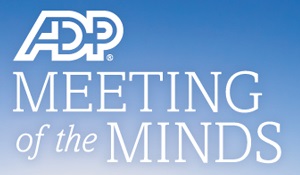
ADP’s CEO Carlos Rodriguez began the company’s annual client conference, Meeting of the Minds, by talking about unprecedented challenges faced, including global talent needs, growing compliance burdens, and rising expectations. And though perhaps not the most original of messages, Rodriguez singled out service as the core differentiator that enables ADP to deliver positive impact on its clients’ business and that differentiates it from software companies. Here I take a look at how ADP’s focus on service as a differentiator cuts across several lines of business.
ADP Comprehensive Outsourcing Services (COS)
COS provides a full range of integrated HR services to clients. Some recent service highlights include:
- With clients using on average ~3 ADP services, an effective governance team process is essential. ADP has taken its operational reviews to the next level, and its value proposition includes 6-month interval reviews to make sure processes are optimized and ROI expectations are met
- Adoption of mobile across all clients has resulted in a reduction of paycheck calls by 14%
- Benefits obtained for a new COS security client included change management workshops and detailed plans to manage organizational change, communication, and people strategy. Plus, process optimization and cost reduction (including pay group consolidation, pay frequency change, go green, and paycard).
ADP DataCloud
Predictive analytics, including Predictive Turnover Probability, are delivering insights including:
- Competitiveness: How much future voluntary turnover might my organization have, relative to others in my industry?
- Hidden Drivers: What combinations of factors are contributing to the likelihood of employees leaving, so I can take action?
- Hotspots: Where are the likely areas of highest voluntary turnover in my organization – within jobs, locations, or teams?
- At-Risk People: Who are the high- and medium-risk employees I need to work to retain?
ADP RPO
Growing from 90 clients in 2015 to 114 today, the majority of new recruitment process outsourcing (RPO) clients are first-time adopters. One of ADP’s competitive advantages is its AIRS Recruiter Training provided internally to ADP staff (who are required to be re-certified every year) and also to clients (for whom 750 classes are held annually, with 10,500 people trained, and 3,600 certified).
2017 investments include:
- Global expansion and capability building in EMEA, APAC and LATAM to support growing U.S. multi-national corporations
- Enhanced RPO analytics and DataCloud Integration, including linking candidate profile data to retention and performance.
Mobile
ADP has 10m+ mobile users, providing capability that includes:
- Accessing and printing pay & W2 statements, access to categorized pay reports, setup of direct deposit, and comparison of pay statements
- Tracking time and timesheet approvals, view, request and approve of time off
- Checking 401k account balances, viewing account performance, and changing contribution rate or account allocation.
Benefits Administration
Providing Benefits Administration for 1 in every 17 employees in the U.S. and 9.4m participants, ADP receives ~850k calls annually to its service center, and first-time call resolution is 90%. Recent client case studies include:
- Upon automating Benefits Administration for its client Areas (including open enrollment), errors were reduced by ~75%, and benefits enrollment was reduced from 2 months to 2 weeks. Client feedback was that this was a smooth experience, the process being intuitive and easy to understand (http://bit.ly/2lB7fBK)
- Sumitomo Electric Wiring Systems turned to ADP for ACA Compliance and automating open enrollment. Feedback from the Corporate Compensation and Benefits Administrator included acknowledgement of ADP’s customer service expertise (http://bit.ly/2hirs9u).
The importance of service
The importance of customer service is hardly a new theme, but it’s worth reflecting on just how much it makes a difference. Consider these statistics:
- Most customers make their decisions on who they will buy from based on service as the most important criterion
- 3 in 5 Americans (59%) would try a new brand or company for a better service experience
- The probability of selling to a new prospect is ~15%. The probability of selling to an existing customer is ~65%
- It is 6.5 times more expensive to acquire a new customer than it is to keep a current one
- 91% of unhappy customers will not willingly do business with you again.
ADP clearly grasps this, and is committed to improved customer service and experience as a core differentiator across its HR business lines.
]]>
By Nikki Edwards & Gary Bragar
In recent industry discussions around talent acquisition, we have identified a number of interconnected trends that are having a significant impact on talent acquisition markets. Here, we take a look at three key trends, and at how HRO vendors in the talent acquisition space are responding.
Socio-economic trends
An ageing, yet multi-generational workforce made up of Baby boomers, Generation X, Generation Y/Millennials and Generation Z (all of whom have different views on how they should work), is complicating the war for talent: it is no longer just focused on permanent hires and contingent workers, but incorporates more complex models such as Statement of Work (SOW), Independent Contractors (ICs)/Freelancers, and the rise of the ‘gig economy’ (where an individual may be working on multiple gigs at any one time).
Vendors are responding by focusing on creative pooling for talent acquisition outsourcing (both RPO and MSP), looking across gender, diversity, veterans, alumni, women returners, university, sectors, geographies, skills, etc. Some MSP vendors are offering services procurement management solutions (managing SOW, ICs, direct sourcing), and offering services around clients’ employer value proposition, and strategic workforce planning, to attract talent.
Talent acquisition trends driven by market maturity
The availability of larger corporations with whom to initially engage in talent acquisition outsourcing is nearing saturation point in the mature markets of U.S., U.K., much of Europe, and Australasia. These corporations, having been the first to consider talent acquisition outsourcing , are now three or four generations into an outsourcing model and no longer offer the growth opportunities they once did. Consequently, new opportunities lie in the mid-market space, and in newer territories (Latin America, Malaysia, China, etc.).
Cost savings made in first generation contracts are more difficult to achieve in subsequent generation contracts. Eking out further cost savings has led buyers to seek ‘total talent management’ (using one provider to manage all talent acquisition, rather than two separate providers for RPO and MSP) or more blended/tailored models (by geography, industry, business function, etc). However, with the levels of cost savings in decline, being innovative and adding value become the key drivers.
Vendors are responding by:
- Shifting towards the mid-market space and/or new territories
- Shifting towards total talent acquisition/management or blended/tailored models
- Enhancing client operational effectiveness/program optimization
- Adding extra services (consultation, insights, client engagement, training, high-touch, legal/compliance, security clearance)
- Shifting the focus of metrics to measure the effectiveness of talent acquisition outsourcing services (including rate management, innovation, strategic guidance, quality, diversity, talent retention).
Technology trends
There is no ‘one-size-fits-all’ talent acquisition technology – rather, there’s a plethora of siloed talent technologies (ATS, VMS, FMS, gig platforms, talent pooling) for different segments (RPO, MSP, Freelancers, etc.) developing at different rates and with multiple providers in each segment (some of whom will fall by the wayside). Consequently, there’s a growing trend for talent acquisition outsourcing vendors to become system integrators to access relevant data across many systems. In some cases, they are developing proprietary APIs to sit across different technologies via a single interface to access relevant data across systems. However, there is also a trend among vendors for establishing technology partnerships with providers of the latest talent technology, rather than develop proprietary solutions from scratch.
But, of course, the big technology story in HR is RPA and AI, with cognitive capabilities emerging. Cognitive tools, including IBM Watson Talent, can help recruiters prioritize and work on filling requisitions based on complexity, skill requirements, data from talent systems, how the job was filled in the past, external market insight, and what the talent supply looks like. RPA and analytics/AI are increasingly being applied to MSP and RPO to improve candidate targeting and quality. This includes analysis of candidate profiles on social networks to determine who is more likely to be receptive to solicitations for jobs, and analytics that show which combinations of words in a job posting generate the most response (and linking them to the quality of the candidates who were ultimately hired).
Nikki, Gary, and NelsonHall’s other lead HRO analysts, Amy Gurchensky and Pete Tiliakos, will be keeping you abreast of all major developments in HRO throughout 2017. To find out about NelsonHall’s extensive research plans for HRO in 2017, contact Guy Saunders.
]]>
Following several years of growth, the HR outsourcing market continues to ride the crest of the wave, and is gearing up for a prosperous 2017 following investments across all service lines. We will shortly be publishing an in-depth blog on HRO predictions for 2017, but first I take a quick look at what happened in 2016 to lay the foundations for things to come, specifically in payroll services, benefits administration, RPO, learning services, and cloud-based HR.
Payroll Services: HCM Integration & Multi-Country Expansion
Highlights in the payroll market in 2016 included an emphasis on integrating payroll systems with HCM software, which is especially important when it comes to multi-country payroll, an area targeted for huge growth over the next three years. In anticipation of multi-country demand, vendors have continued to expand their payroll capabilities, with ADP’s payroll services now extending to ~111 countries, and NGA HR launching a payroll offering across 33 LATAM countries.
Other 2016 milestones reached in payroll services include Paychex exceeding 1m worksite employees serviced across its payroll and PEO offerings, and OneSource Virtual (OSV) exceeding 500 clients, while maintaining a client satisfaction rating of 98%.
Benefits Administration: Private Exchange Momentum
Private exchanges continued to gain momentum over the last year. Fidelity investments expanded its PIX, focused on SMBs, beyond Massachusetts and New York to Colorado and California, and Morneau Shepell launched a retiree PIX in Canada, adding 3M Canada as its first client. Vendor priorities have been focused on integrating voluntary benefits into the exchanges as well as within traditional H&W administration offerings.
Private exchanges are growing at 6% CAAGR through 2020, and Willis Towers Watson, with ~20% market share, is gearing up to capitalize on the growth in 2017 after recently expanding its delivery center in Arizona, to which it will continue to add headcount over the next year.
With respect to DC administration, Fidelity enjoyed another successful year, adding $65bn in new DC plan sales across ~1.3k employer clients in H1 alone. In addition, as of mid-year, Fidelity already had another $14bn in commitments for 2017.
Benefits administration acquisitions really heated up in H2, with Mercer making some key purchases, including Pillar Administration in Australia (which now makes it the largest superannuation provider in the country) and Thomsons Online Benefits, adding its global cloud-based benefits technology platform, Darwin.
RPO: M&A Hotspot
There were ~25 HRO acquisitions in 2016, ~40% of which were focused on RPO. Many of the acquisitions focused on expanding or strengthening geographic capabilities, especially for Randstad who acquired Penna in the U.K., Obiettivo in Italy, Careo Group in Japan, and BMC in the Netherlands.
And, while the U.S. and the U.K. markets are the most active for RPO, emerging markets in APAC and LATAM have high growth potential over the next few years.
Learning Services: Shift to Performance Targeting
The most significant change in the learning services market is the shift away from a transactional approach that pushes a catalog of service offerings towards an approach that leads with targeting performance objectives. On the backend, automation and analytics are key components of the performance-centric approach.
Trending themes by learning function include the following:
- Content: content curation services
- Delivery: digital modalities
- Administration: RPA
- Technology: cloud-based Learning Management Systems.
Cloud-based HR Services: Focus on Rapid Deployment
The cloud-based HR services market, including cloud consulting, implementation, AMS support, and HR BPaaS, took 2016 by storm. Key priorities were focused on launching guided implementation tools for rapid deployments, for example:
- NGA HR launched NGA FastTrack to rapidly deploy SAP SuccessFactors
- Ceridian launched Dayforce Activate, which shortens the implementation lifecycle to provide clients with a faster ROI
- Neeyamo launched Rapid Deployment for SAP SuccessFactors, which allows go-live to be achieved in 21 days
- Aon Hewitt launched a rapid deployment offering for mid-market organizations (1.5k-7k employees) who are migrating to Workday from a payroll service bureau provider, activating Workday core HR, U.S. absence, U.S. benefits, and U.S. payroll, including payroll settlement, check print, garnishment admin, and tax filing services in ~5 months.
Other initiatives were focused on ramping up delivery capabilities, with Zalaris opening a COE for SAP SuccessFactors in the Nordics, OSV opening a center in Ireland to provide support around Workday, and Neeyamo launching a SuccessFactors Employee Central service center.
All cloud-based platform providers, including SAP SuccessFactors, Workday, Oracle, ADP, Ceridian, and Ultimate have robust pipelines and roadmaps for continued innovation, making this one of the key areas to follow in 2017.
]]>
Seven Step RPO recently held its first analyst event, which featured a select group of analysts and recruitment SMEs, two clients, and six members of the Seven Step leadership team. This made for an engaging dialogue around Seven Step RPO’s services, strategy, and best practices, with both clients (CVS Health and engineered product firm TriMas), contributing to the discussions throughout the day. Here I take a look at some of the main RPO themes that emerged.
The importance of company culture
Both CVS Health and TriMas identified the importance of company culture when working with an RPO provider. This includes:
- Leading on values – e.g. CVS Health recognized that Seven Step RPO shared its own belief in recruiting on values first
- Willingness to learn – the RPO vendor may not know everything on day one, but a willingness to learn and adapt is essential, particularly if the environment the vendor is recruiting for is constantly changing
- Quality and strength of the vendor team – e.g. TriMas identified the seven-step career path of Seven Step RPO’s recruiters as one of the reasons they chose to work with them
- A ‘can do’ attitude – something that both CVS Health and TriMas attribute to Seven Step’s rigorous training. There are ~160 specialized training courses and eight certifications, with recruiters receiving an average of 60 hours training annually
- Openness – e.g. in allowing direct access to the vendor’s senior leadership, as well as knowing the Seven Step delivery team on a first name basis.
Scalability
TriMas stressed the importance of wide country coverage, with Seven Step now delivering RPO in ~45 countries across North America, Latin America, Europe, Middle East and Asia Pacific. However, as TriMas is an acquisitive organization, scalability is just as important. According to NelsonHall’s recent RPO market analysis study, scalability and agility to meet business needs is the top driver for RPO.
CVS Health also highlighted scalability as a key capability. Seven Step currently hires ~3,500 personnel annually for CVS, and is capable of scaling up or down quickly. This is evident in the floor plan Seven Step uses for its recruiters, with client-dedicated pods designed with flexibility in mind so that recruiters can move quickly between clients as needed.
Predictive capability
Seven Step RPO’s Talent AI (Actionable Insights) predictive analytics platform allows it to make proactive and insightful suggestions to improve the quality, quantity, and timeliness of talent acquisition decision-making. The reports library is extensive and fully customized to the SLA/KPI strategy for each client, giving clients a high level of recruitment visibility.
Predictive decision-making is one of the key tenants of CVS Health’s talent acquisition strategy, and it is the first client to use Seven Step’s Talent AI directly themselves (at manager level). It also plans to extend this to their own recruiters.
Outlook
The company has been selective in choosing the right clients they can grow with and transform, while at the same time not growing so fast that they have difficulty meeting client needs. Its delivery centers are currently in the U.S. (Boston and Denver) and in the U.K. (Reading and Devon). To date this has worked well in terms of meeting client needs, as they are prime locations to attract recruiter talent. However, as they are higher rent locations, Seven Step is also now looking at offshoring opportunities, possibly in India and Manila, for some of its back office administration as well as in-region support.
]]>
ADP’s recent annual Analyst Day was held at its new Innovation Lab in Pasadena, California, with CEO Carlos Rodriquez and others articulating ADP’s strategy and vision for its clients. Top of Rodriquez’s list of priorities was the ability to meet the global talent needs of clients, the importance of which was underscored by several client presentations, including one from Irma Long of Follett Corporation, the focus of this blog.
Rodriquez’s opening remarks reflected ADP’s strong focus on talent management, including:
- Recognizing that the job of the CHRO has changed, and is now focused on attracting the best talent
- The importance of focusing on the user and associate experience
- The objective of solving clients’ business problems seamlessly and completely (including via ADP’s HCM solutions).
Addressing Follett’s requirements
Follett Corporation is the world’s largest source of books, entertainment products, digital content, and multi-media for libraries, schools and retailers. Follett has 10k associates and averages 18k employees during its busy season.
Amongst Follett’s HR requirements was the need for a recruitment system that was configurable and simple to use, and that alleviated their store managers from the burden of recruitment. Follett also wanted to improve the candidate experience.
Follett is an ADP Vantage HCM client, with services that include HR, Payroll, Benefits, Recruitment, Onboarding, Talent Management, Background Screening, and ADP DataCloud. To help fulfill Follett’s recruiting needs, ADP held a 2-day brainstorming session with the client. As a result, ADP was able to significantly improve the candidate experience for Follett, with initiatives including:
- Employment Branding, with the objective of treating candidates as individuals, and not just as a set of résumés. An interactive website was implemented, which gives candidates the ability to chat instantly with recruiters. In addition, to maximize candidate engagement, the website includes fun facts about Follett in the form of a scavenger hunt. When one question is completed, candidates move forward in the maze
- Thank-you emails to candidates visiting the website, including links to a tool to help candidates with their job search
- Talent Communities, which includes the ability for the CMO to talk to the candidate audience with a video presentation of what it’s like to work at Follett
- Social distribution of job openings, including via Facebook and Twitter, were used to improve visibility (as a lot of the candidates were not familiar with Follett).
Quantifiable results
Results to date include:
- Candidate satisfaction improved by 80%
- 90% of candidates said they would refer other candidates to Follett (even if they did not get the job)
- Candidate traffic on the Follett website increased by 90% (>200k applicants YTD)
- Process optimization reduced hiring manager workflow from 12 to 2 steps.
In NelsonHall’s recent interviews with the clients of RPO vendors, improvement of candidate satisfaction was ranked as the third most important expected benefit, after improved scalability and improved quality of hire. Although Follett is an ADP Vantage HCM client and not a full RPO client using ADP recruiters, it is still a good example of how an outsourcing provider can greatly improve a client’s recruiting process via an effective combination of service and technology.
]]>
Employer branding has become an integral component of an effective talent strategy. It is synonymous with a company’s reputation as an employer, portraying the image of what the company is like to work for. The purpose of properly conveying and clearly communicating an employer’s brand is essential to attract, engage, develop, and retain the best talent for an organization. Here I take a look at an example of employer branding that has worked well, producing quantitative results: IBM and its real estate client Waypoint Homes.
Employer branding is already evident in ~48% of RPO contracts today, and NelsonHall’s recently published RPO market analysis reveals that employer branding is increasing in future importance to clients by 10%.
RPO critical success factors include providing consulting services that include talent pool development and employment branding, and convincing clients of better results through candidate engagement, including developing employer brand messaging to attract candidates with cultural fit and improved retention.
Waypoint’s Decision to Outsource
Prior to outsourcing to IBM Kenexa, Waypoint Homes used internal recruiters, contract recruiters, search firms, and placement agencies, which Waypoint found to be ineffective. The principle reasons for deciding to outsource were to:
- Reduce costs
- Attract top talent
- Improve the recruiting and hiring process
- Reduce screening and interviewing time by hiring managers, and focus on its core business
- Grow from a small to mid-sized public company, be able to rapidly scale up as well as down (given the uncertainty of a start-up), and not have to worry about hiring recruiters and downsizing them should a reduction in staff be required.
Services In-Scope
IBM Kenexa was chosen from among four potential RPO providers, with employer branding in-scope, which includes:
- Culture research
- Employee value proposition creation
- Career website development, replacing an inadequate career site.
One of IBM Kenexa’s first projects completed was quantitative and qualitative research to assess Waypoint’s organizational culture. An IBM Kenexa Organizational Cultural Insight Survey was conducted, as well as stakeholder interviews and a review of company data. In eight weeks, Waypoint realized benefits from using IBM Kenexa Recruitment Services and IBM Kenexa Employment Branding, including being able to more clearly articulate company culture, and to provide input to the development of a new career website to help candidates better understand what it’s like to work at Waypoint.
Also delivered early on, IBM Kenexa rewrote existing job descriptions to be better suited for external job postings, with clearer language, and including a description of the impact these jobs have on the company.
Managers were trained in behavior-based interviewing skills, and interview guides were created for all common job types, including guidance for managers on how to assess candidates for cultural fit.
In addition, the IBM Kenexa recruitment manager was located at the client site to better understand Waypoint’s culture and to build effective relationships with hiring managers.
According to Andrew Bartlow, VP HR at Waypoint Homes, “the cultural work provided by employment branding was a huge value-add that IBM Kenexa brought to the table, in a very short time; their support helped us to more effectively source and select the kind of talent we need to be successful.”
Results Achieved
Tangible results arising from the outsourcing arrangement were:
- Cost Per Hire reduced by ~20%
- Within seven months, reduced ‘time to fill’ by ~35%
- Reduced turnover by ~22%
- IBM Kenexa RPO was able to immediately source 100% of Waypoint’s targeted hiring needs in year one, scaling up and down as needed
- Reduced administrative burden. Bartlow commented, “From IBM, we’re getting candidates with a higher hit ratio. When a candidate is presented, they are more likely to be hired than they used to be, and they’re much more likely to stay with us, and we are getting great quality candidates now. Our managers used to spend a lot of time screening and onboarding new people, when we really want them to be servicing our residents”.
NelsonHall’s RPO NEAT client survey reveals that, overall, vendors are doing well regarding clients’ employer branding expectations: satisfaction with improved employer branding exceeds current importance by 8%. In the case of IBM’s own client ratings, satisfaction exceeded importance by 20%, confirming IBM’s ability to add value in this area.
Given that future importance of employer branding is increasing, I expect employer branding to be included in ~60% of RPO contracts within three years.
]]>
As earnings are released, it’s a good time to reflect on HR outsourcing trends by key service line. Here’s a brief round-up of market activity across payroll, RPO, and learning services in H1 2016.
Payroll
Payroll activity has been bustling in Europe YTD, with a strong emphasis on ramping up capabilities. SD Worx made two acquisitions to accelerate its growth across Europe, including Ceridian U.K. and Ireland, and Fidelis HR in Germany. Already the largest payroll provider in Benelux, SD Worx strengthens its footprint across EMEA through these acquisitions.
Continuing its expansion, Workday launched payroll in France. At the same time, Workday partners providing cloud-based HR services such as OneSource Virtual (OSV) and NGA HR have been expanding delivery capabilities in Europe as follows:
- NGA HR opened a new center in Bristol, England, that will also be an innovation hub for cloud HR, payroll, analytics, and HR BPaaS
- OSV launched the next phase of its European service center in Derry, Ireland, which currently has ~100 employees.
For leading payroll outsourcing providers, multi-country capability is a critical success factor, and most vendors continue to expand their footprint globally, e.g. ADP recently added payroll support for Angola, Azerbaijan, Guam, Mozambique, Puerto Rico, Tanzania, and Zambia.
For more insights into the payroll market, NelsonHall will be publishing its Next Generation Payroll Services market analysis in August.
RPO
The RPO market continues its evolution. NelsonHall estimates that ~43% of all RPO contracts include multiple countries in scope. Therefore, many vendors have been focused on expanding their geographic presence. Examples include:
- Randstad in Japan and Italy via its acquisitions of Careo Group and Obiettivo Lavoro respectively
- Cielo in Asia Pacific by expanding its delivery support in Singapore
- Adecco Group in the U.K. by acquiring Penna’s career and talent solutions business
- Alexander Mann Solutions by opening a second delivery center in Poland.
Learning
Contract activity for learning BPO (LBPO) was up significantly relative to H1 2015 across various verticals, including manufacturing, with wins focused on the automotive sector including:
- Raytheon Professional Services won a three year contract with BMW in Northern Europe for delivery, administration and management, deployment, and local adaptation services
- GP Strategies winning an automotive training contract with a Korean OEM as well as an operations training contract with a European Luxury OEM.
Also noteworthy was HSBC’s two-year extension with GP Strategies; HSBC is GP Strategies’ largest LBPO client.
Stay tuned for more highlights and trends from H1 2016 specific to benefits administration.
]]>We interviewed RPO vendor clients in North America, Europe, and Asia Pacific, looking at over 50 specific RPO service criteria. In each case, we ascertained importance and satisfaction levels, plus a measure of future importance. Below is a small selection of potential benefits from RPO showing the levels of importance and satisfaction for each.
Areas where vendors are under performing against client expectations are scalability, quality of hire, and hiring manager satisfaction.
Scalability: the biggest challenge for RPO vendors
While client satisfaction with scalability is high at 80%, it still falls 10% short of the importance placed on this performance measure. Our latest research identifies scalability and agility to meet business demands as the top driver for companies outsourcing recruitment today, and this has become the biggest challenge for RPO vendors. Comments from vendor clients included:
“That was one of the compelling reasons to outsource”
“Great job for effort, but only a good job for delivery”
“They are able to scale down well, but not able to scale up fast enough”
“There is an inability to bring in the right resources when scaling up”
Quality of hire & hiring manager satisfaction: could do better
Quality of hire also falls into the ‘could do better’ category, with clients pointing to issues such as:
- Need for improved quality in the selection process
- Poor cultural fit of candidates
- Lack of metrics to demonstrate quality of hire.
Similarly for improved hiring manager satisfaction, where clients asserted that vendors need to:
- Be more proactive
- Provide more of a high-touch and relationship focus
- Be more realistic and manage expectations better
- Make better use of data related to available talent to hire.
Doing well, keep it up, and even more please
Vendors are exceeding client expectations by a healthy margin in the areas of support for new regions/countries/languages, predictive analytics, diversity, candidate retention, and employer branding. However, the increased levels of importance placed on future service delivery make these the main areas where vendors need to maintain momentum and look to deliver even more in the future.
In addition, while improved candidate experience and ability to tie results to business outcomes are meeting current expectations, future importance shows a 10% increase in both cases, while the future importance of reduced time to hire and reduced cost of recruitment both show an 8% increase. These too are areas where vendors need to continue improving.
In summary, client satisfaction with RPO across a range of service criteria is holding up well, and exceeding expectations handsomely in some cases. However, there is never a good time for sitting on laurels, and future client expectations demand that vendors redouble their efforts to satisfy clients across the board. Meanwhile, addressing those areas showing a significant delta between expectation and performance must be the priority for RPO vendors.
~~~~~~~~~~~~
NelsonHall’s NEAT comparative vendor assessments look in detail at vendors’ ‘ability to deliver immediate benefit’ to their clients, and their ‘ability to meet future client requirements, and assist strategic sourcing managers in assessing vendor capability while cutting the time and cost associated with their sourcing projects.
The RPO NEAT shows how 19 RPO vendors are positioned overall in terms of their ability to deliver RPO services, as well as within three distinct market segments (i.e. areas of focus designed to meet specific recruitment requirements): these are Candidate Focus, Talent Management Focus, and Global/Multi-Country Focus. The NEAT online tool also enables buy-side organizations to input their own weightings and tailor the RPO dataset to their specific requirements across over 50 individual vendor evaluation criteria. In this way, sourcing managers can configure the NEAT evaluations in accordance with their own priorities and business requirements for service offerings, delivery capability, customer presence, benefits achieved, and other criteria.
]]>
RPO provider PeopleScout recently held a client forum to discuss key recruitment themes, one of which was a discussion around Diversity and Inclusion (D&I) led by Dr. Arin Reeves. This focused on the importance of D&I, including the tendency for diverse groups to outperform non-diverse groups in solving problems, and how D&I can support the hiring process.
Tips on how D&I can support the hiring process included:
- Video interviewing – this is still valuable, and can actually reduce selection bias so long as interview guidelines/questions are issued beforehand
- Talent acquisition needs to be connected to talent development – every time there’s attrition, it makes it harder to retain others. Insist that talent acquisition is part of the onboarding process, including following up quickly with new hires after they have joined to make sure they are getting what they need
- Talent acquisition also needs to be part of the exit interview process to find out why people are leaving, and to feed data back to leadership for improvement opportunities, and to help talent acquisition teams in recruiting talent that is more likely to stay. Exit interviews are best conducted by third parties, as employees tend to be more honest and open regarding reasons for leaving than they would be with their own employer
- Talent acquisition teams should also conduct ‘stay’ interviews to find out why people remain with the company. This is helpful in determining how to improve employee engagement, and in turn helps with employer branding (see my earlier blog on Employer Branding: An essential Talent Management Strategy)
- The resume (CV) stage can be the most biased part of the process, as someone reviewing a resume may start to make judgments before having spoken to the candidate. Good practice includes simple actions such as taking notes separately during a candidate interview rather than annotating the resume
- Obviously, but importantly, don’t make hiring decisions until you see sufficient candidates. This can be a challenge, as RPO vendors try to put forward the best, but fewest, candidates for hiring managers to interview to help the business save time. Talent acquisition needs to be part of workforce planning with the business, and engage in discussions around the optimum number of candidates to be interviewed.
As part of NelsonHall’s recent RPO market analysis, interviews were conducted with clients of ~20 leading RPO vendors, which included a question on the vendors’ ability to ‘improve diversity of employees’. PeopleScout’s customer satisfaction score was 10% higher than the overall RPO industry average, which indicates that its focus on getting D&I right is paying off.
More widely, all RPO providers need to continue improving the diversity of their clients’ workforce. In our survey, clients rated the ‘future importance’ of diversity to be on average 18% higher than ‘current importance’.
In July, I will publish a blog on overall RPO client satisfaction, along with current and future importance in key areas such as diversity, quality of hire, and employer branding.
]]>
Yesterday, the people of the U.K. did what many thought unlikely, and voted the nation out of the European Union (EU). And while the wider political ramifications surrounding ‘Brexit’ start to unravel, what might be the impact on talent acquisition and the related outsourcing industry?
It’s still unclear what kind of agreement Britain and the EU will negotiate post-Brexit, but the options are that Britain could become a virtual associate member (like Norway) and participate in the single market, pay budget dues and open its borders to EU workers, or it could choose a more drastic and estranged relationship, taking back full control of its borders and reducing the number of people who are able to come and work in the U.K.
Free movement is one of the most important principles of EU membership, allowing individuals from any EU country to live and work in another EU country without the need for a visa. And if the U.K. takes back control of its borders, this would mean the flow of individuals both into and out of the country would be limited to those who are able to obtain visas.
U.K. skills shortage & the impact of border control
This is likely to impact U.K. companies and their ability to attract talent into the country. There are currently ~2 million EU nationals working in the U.K. (as referenced by the latest ONS statistical bulletin, U.K. Labour Market 2016), and U.K. companies are used to employing people from across the EU because of a lack of qualified talent with the skills and experience businesses need. By imposing restrictions on those wishing to move to the U.K., this could compound the issue and make it a less attractive prospect for the best talent to relocate there. An obvious consequence of closing its borders is that the U.K. would increase the number of jobs available to U.K. citizens, but what happens in industries where those skills simply don’t exist?
If the U.K. imposes visa restrictions, not only might the U.K. be a less attractive work destination, it could also restrict the freedom of movement of U.K. workers seeking opportunities abroad; this is at odds with the new world of work, with more and more workers wanting to travel, and wanting the ability to work from anywhere, any time. If the U.K. were to close its borders, it may put a premium on in-demand skills and will certainly cost businesses time and money in order to recruit and retain talent. There are some who also believe that foreign companies may scale back their operations in the U.K., and whilst this may have a negative impact on the jobs market, there is also the question of how many jobs this would create in the wake of the U.K.’s exit.
Considerations for talent acquisition teams
It is unlikely that we will see many changes immediately, as the U.K. will need to continue to abide by EU treaties and laws for at least the next two years. One thing is for sure: now that the U.K. has chosen to leave the EU, talent acquisition teams, whether in-house, outsourced, or even agency side, will need to watch the developments closely to understand the impact it’s likely to have on their working practices, their underlying processes, their pricing mechanisms, and their compliance responsibilities.
Those vendors in existing outsourced relationships will need to consider the cost implications to themselves and the client associated with recruiting and processing candidates on visas, the likely increase in time to hire, the impact on SLAs and any risk/reward pricing, and the additional complexity this may add to their recruitment process.
On the other hand, the U.K.’s exit could create opportunities for outsourcing companies to support new businesses who may not have the in-house skills and capabilities in sourcing, hiring and retaining staff, and also in upskilling and training existing employees to fill the skills gap. Companies may require additional support in managing recruitment processes that involve visa applications, and there will be opportunities for outsourcing vendors who provide L&D services to help with training and upskilling existing employees.
Quite what the full implications of the vote to ‘Brexit’ are, no-one yet knows. The only certainty right now is uncertainty.
]]>KellyOCG is the outsourcing and consulting group of Kelly Services Inc., and represents the largest growth segment of Kelly Services. In 2015, Kelly Services reported revenues of $5,518m, down 0.8% y/y (or up 4.7% in constant currency), while KellyOCG’s revenues were $674m, up ~15% y/y from $587m in 2014 and +16.6% in constant currency. KellyOCG’s operating profit in Q4 2015 was $14m, up 44.3% y/y, while gross profit was $48m, up 13.5% y/y. The largest profit and revenue growth came from MSP followed by RPO.
Within MSP, KellyOCG has 4,600 registered and active suppliers with $7.2bn total spend under management, which according to NelsonHall, puts KellyOCG among the top tier of global service providers. There are ~232 MSP clients across the Americas, EMEA and Asia Pacific with a 99% client retention rate.
KellyOCG has ~50 RPO clients, including ~14 new clients since January 2015, and in 2015 performed ~47,000 hires in the Americas, EMEA and Asia Pacific. Its longest running RPO client has been with them for ~20 years. A recent trend has been clients starting with project RPO for a specific number of hires and then, once benefits are realized, expanding into full RPO clients.
Talent Management Consulting
KellyOCG began providing talent management consulting services in Q1 2015. Services are typically provided with RPO and MSP and include:
- Talent Strategy Advisory, which includes: Strategic Workforce Planning, Process Optimization, Business Care Development, Talent Strategy Alignment
- Talent Attraction and Engagement, which includes: Specialized Career Events, Employer Branding, Candidate Experience Measurement, Talent Community Management
- Workforce Governance and Execution, which includes: Program Structure & Governance, Market & Competitive Intelligence, Program Performance Management, Change Leadership
- Talent Counseling, which includes: Career Transition, Outplacement, Executive Coaching, Leadership Development
- Workforce Analytics, which includes: Labor Market Intelligence, Talent Supply Chain Analytics, Business Process Analytics, Predictive Analytics.
Talent Supply Chain (TSC) Analytics
KellyOCG’s TSC Analytics Portal helps to give clients insights to drive change, and focuses on:
- Rate analytics: providing insights on current spend and competitiveness by supplier, geography, and marketplace
- Supplier optimization: providing insights on supply chain attributes of time, cost, and quality
- Order efficiency: providing insights on cycle type, benchmarking on efficiency of the supply chain, and on risk due to aging orders
- Workforce planning: providing insights on percentage breakdown of workforce, trends, alignment to workforce plan, how sourcing aligns and compares, where changes can be made to optimize cost, and where talent pools can be implemented. This includes the ability to view attrition by region, country, state, client, vertical, etc. and also compare how a particular client compared to all other clients. Scatter diagrams can also be used to view tenure and attrition rates for FT and temp workers.
Predictive analytics are also provided, e.g. clients can predict when aging orders are going to cancel, and also predict cycle times, and recommend what can be done to improve performance.
Over the last year, KellyOCG has focused investment on delivering analytics to support its MSP offering and has recently deployed its offering across RPO and is now focused on enriching the data. New clients will have the toolset implemented within 3 to 6 months. All clients get the analytics portal included with the program and can do their own analysis or, if they prefer, can pay extra for help with analysis.
In Summary
In NelsonHall’s latest RPO Market Analysis published last week, we report that the key client drivers for RPO adoption include the ability to improve performance and meet business demands, and clients are looking for providers with broader talent management consulting capability and talent analytics for improved decision making. In this regard, KellyOCG is addressing the right client issues.
Future market needs will include more upfront strategic talent consulting and longer term workforce planning. Service offerings are expected to develop in the areas of consulting services, analytics, and assimilating labor market data, to support better planning and sourcing choices. Increasingly, RPO contracts will be bundled with consulting services as RPO clients expect higher quality and more value.
NelsonHall has just published a comprehensive global RPO Market Analysis report, plus associated RPO vendor profiles, including KellyOCG. For more details, contact Guy Saunders.
]]>However, of all of this, I believe a key ingredient to Cielo’s success is its strong candidate focus, something that was highlighted on a tour of their Impression Center and Bridge Center.
Impression Center: A High Touch Candidate Experience
The purpose of the center is to ensure a high touch experience with the candidate and not tie up recruiter time (with a resulting 96% reduction in unnecessary calls to recruiters). Satisfaction is immediately evidenced upon entry to the center with a bulletin board displaying notices of candidate accolades relating to Cielo’s performance throughout the recruitment process. Scorecard data includes first call resolution of 96% and candidate satisfaction of 96%.
When candidates call into the Impression Center with an inquiry about a job opportunity with a specific client, they do not know they are speaking with Cielo. For example, Comcast has Cielo recruiters dedicated solely to candidates applying for Comcast jobs. Every client has a specific phone number which connects to Cielo recruiters trained on serving that client. Recruiters know who is calling and then log into the system for that account, prepared to answer the candidate question. On an average day there are 1,435 client interactions, of which 85% are calls, 13% are email and 2% are live chat. The high percentage of phone calls is an interesting and important statistic given that there is an upward industry trend in usage of live chat, but given the high touch and positive experience candidates have with Cielo recruiters, the vast majority would rather call than chat. The Impression Center is a service clients do not have to pay extra for and is a value-added service.
Bridge Center: Elevating Candidates’ Pre-Employment Experience
After a candidate is offered a job and accepts, there are pre-employment background and drug screens provided by the Bridge Center. Formerly, recruiters used to perform these screens but then would not have time to follow up with candidates on their status in a timely fashion. Now, upon being offered a job, each candidate gets a welcome call and email with an explanation of the process from the Bridge Center. Results include:
- 100% of new hires receive a welcome call
- 30% average reduction in time to clear
- 100% compliance with organization, local, state and federal regulations
- 98.6% of hiring managers surveyed agree that “my candidates’ pre-employment experience is elevated through their interactions with the Bridge Center”
- >50,000 candidates were processed through the Bridge Center in 2015.
The process has been so successful that Cielo has three standalone Bridge Center clients and three in the pipeline.
Per NelsonHall’s latest RPO research, clients’ top vendor selection criterion is recruitment capability, with expectations of high candidate engagement and satisfaction. Hence, it’s easy to understand why Cielo has been successful, growing revenue at ~25% CAAGR since 2011. Given its global expansion and its strong focus on candidates, including building and managing talent pools, I expect that Cielo will continue to have double-digit profitable growth.
]]>
On 23rd June, the people of the U.K. will have the opportunity to vote on whether or not to stay in the European Union (EU). But while the wider political debate surrounding a possible ‘Brexit’ rumbles on, what might be the impact on talent acquisition and the related outsourcing industry?
It’s still unclear what kind of agreement Britain and the EU would negotiate post-Brexit, but the options are that Britain could become a virtual associate member (like Norway) and participate in the single market, pay budget dues and open its borders to EU workers, or it could choose a more drastic and estranged relationship, taking back full control of its borders and reducing the number of people who are able to come and work in the U.K.
Free movement is one of the most important principles of EU membership, allowing individuals from any EU country to live and work in another EU country without the need for a visa. And if the U.K. were to take back control of its borders, this would mean the flow of individuals both into and out of the country would be limited to those who are able to obtain visas.
U.K. skills shortage & the impact of border control
This is likely to impact U.K. companies and their ability to attract talent into the country. There are currently ~2 million EU nationals working in the U.K. (as referenced by the latest ONS statistical bulletin, U.K. Labour Market 2016), and U.K. companies are actively seeking to employ people from across the EU because of a lack of qualified talent with the skills and experience businesses need. By imposing restrictions on those wishing to move to the U.K., this could compound the issue and make it a less attractive prospect for the best talent to relocate there. An obvious consequence of closing its borders is that the U.K. would increase the number of jobs available to U.K. citizens, but what happens in industries where those skills simply don’t exist?
If the U.K. leaves the EU and imposes visa restrictions, not only might the U.K. be a less attractive work destination, it could also restrict the freedom of movement of U.K. workers seeking opportunities abroad; this is at odds with the new world of work, with more and more workers wanting to travel, and wanting the ability to work from anywhere, any time. If the U.K. were to close its borders, it may put a premium on in-demand skills and will certainly cost businesses time and money in order to recruit and retain talent. There are some who also believe that foreign companies may scale back their operations in the U.K., and whilst this may have a negative impact on the jobs market, there is also the question of how many jobs this would create in the wake of an exit.
Considerations for talent acquisition teams
If the U.K. does decide to leave, it is unlikely that we will see many changes immediately, as the U.K. would need to continue to abide by EU treaties and laws for a minimum of two years following the decision. One thing is for sure: by choosing to leave the EU, talent acquisition teams, whether in-house, outsourced, or even agency side, will need to watch the developments closely to understand the impact it’s likely to have on their working practices, their underlying processes, their pricing mechanisms, and their compliance responsibilities.
Those vendors in existing outsourced relationships will need to consider the cost implications to themselves and the client associated with recruiting and processing candidates on visas, the likely increase in time to hire, the impact on SLAs and any risk/reward pricing, and the additional complexity this may add to their recruitment process.
On the other hand, an exit could create opportunities for outsourcing companies to support new businesses who may not have the in-house skills and capabilities in sourcing, hiring and retaining staff, and also in upskilling and training existing employees to fill the skills gap. Companies may require additional support in managing recruitment processes that involve visa applications, and there would be opportunities for outsourcing vendors who provide L&D services to help with training and upskilling existing employees.
Quite what the full implications of a possible Brexit are, no-one knows. As with almost every aspect of the Brexit debate, the only certainty right now is uncertainty.
]]>Xerox focused on the importance of ensuring the right job fit for candidates. Aside from reducing recruiting time and improving retention, ensuring the right job fit is important from a cost perspective. Data revealed that the cost of a bad hire can be ~30% of an employee’s first year salary, and to replace an employee can cost ~150% of salary.
Ideally, companies should be using assessments to determine both job fit and cultural fit. However, only 30% of organizations use cultural fit questions when assessing candidates, which is surprising, as poor cultural fit is one of the top reasons why employees leave. It is important for candidates to know about the values of their prospective employer, their views on work-life balance, and so on.
An increasing number of companies have contracted to evaluate candidates prior to onboarding using Massive Open Online Courses (MOOCs) and ~75% of organizations using MOOCS say they have had a positive impact on hiring and recruiting. However, the downside of MOOCs is that completion rates are very low. Also popular are Small Private Online Courses (SPOCs), but whether companies use MOOCs, SPOCs, or other forms of candidate evaluation, the fact remains that companies can’t afford to make wrong hiring decisions. Allowing candidates to self-opt out of the application process during assessment is an effective way of enabling hiring managers to focus their time on more suitable candidates and improve quality of hire.
RPS and K4 presented data to further support the case that organizations need to hire the right talent the first time. The global workforce is aging, and more people are retiring: the median age of the workforce increased from 39.4 years in 2000 to 42.3 years in 2012. However, at the same time, tenure has decreased from 4.6 years in 2000 to 3.5 years in 2012, with millennial tenure at only 2.3 years.
While there were ~5.6 million unfilled American jobs at year-end 2015, 41% of organizations report that the labor pool does not meet their hiring needs. So, in addition to needing to hire the right talent, it is imperative to ensure an effective onboarding process to retain talent at the start. However, 30% of organizations rate their onboarding process as ineffective, and 54% rate onboarding as only somewhat effective. But for those organizations who rate onboarding as effective, 84% say best practices include instructor-led training, shadowing, and short-form content. In summary, effective learning starts at the very beginning of the employee life cycle with pre-employment, then progresses to onboarding, knowledge capture, and knowledge transfer.
Given the skill set shortages faced by many companies, there will need to be tighter linkage between recruiting and learning to ensure that any new hire skill gaps are addressed by immediate learning plans. I will look more closely at the connection between recruiting and learning in an upcoming blog.
]]>Capita
In December 2015, Capita acquired the consultancy and resourcing operations of Work Group to strengthen its employer branding and employee engagement consulting capability. Earlier in 2015 Capita also acquired ThirtyThree to expand its recruitment services and employer brand consulting capability. Combined with Work Group, who have offices in the U.K., New York, and Hong Kong, Capita Resourcing will be able to expand its service offering to MNCs in North America and Asia. Initially the New York office will provide consulting services for employer branding, candidate communication and employee engagement. Growth plans in the short-term include sourcing services to include talent search and talent pipelining as well as locally delivered pre-employment screening services. In the medium-term, Capita plans to deliver RPO services from New York to clients with operations in North America. In addition, Capita recently established a sourcing operation in Krakow. Capita’s next target for global delivery expansion is Singapore, to serve clients in Asia Pacific along with Hong Kong. Via the acquisition of Work Group, Capita also acquired its candidate management and assessment business in Colchester, U.K. which is heavily focused on graduate recruitment.
Capita’s recent acquisitions expand its geographic capability and broaden and strengthen its service offerings. Capita will target U.K.-based MNCs, while emphasizing its focus on employer branding, employee engagement and the employee value proposition.
RTM
Upon completing its acquisition of Consort Group, Rethink Talent Management rebranded to RTM on February 10. In 2015, Consort Group was acquired to expand and strengthen RTM’s RPO and recruitment consulting capability, with services including:
- Employment branding and attraction
- Talent pooling and talent profiling
- Onboarding
- On-demand services
- Permanent and contingent hiring using RPO (the predominant model) and MSP.
The acquisition expanded and strengthened RTM’s RPO services, including in the financial services and retail sectors. RTM is now able to provide Consort’s RPO and talent management offerings to existing clients and vice versa. RTM had already been providing employer branding and MSP services, but Consort strengthens RTM’s offering, the primary focus of which will be on talent acquisition.
RTM is targeting U.K.-headquartered organizations with a global presence. RTM already has global contracts, including clients with employees in Canada and South Africa served from the U.K. and in Asia Pacific served from Melbourne and Singapore. RTM provides service employees onsite and also utilizes recruitment partners in its aforementioned hubs. European client locations, including Germany, are serviced from the U.K. and Ireland, specifically from its Dublin and Cork offices. Client locations in South America will be serviced via partners.
The above expansions and enhancements of service offerings are more important than ever as clients seek to attract the right talent for the right jobs, and with high retention rates. In addition, there continue to be more and more MNCs looking to expand RPO to additional countries. NelsonHall research shows that currently ~ 1/3 of all RPO contracts are multi-country, and we forecast this to increase to ~ 50% within four years. We also expect further vendor consolidation and partnerships, as providers continue to strengthen their service delivery and geographic capability.
]]>- TrueBlue’s acquisition of Aon Hewitt’s RPO business
- The completion of the merger between Pontoon and its sister company, hyphen
- Orion International’s acquisition of Novotus
TrueBlue acquires Aon Hewitt’s RPO business
TrueBlue, via its PeopleScout RPO business, acquired Aon Hewitt’s RPO business and also announced a broader, ongoing relationship to connect PeopleScout’s recruiting services with Aon Hewitt’s assessment, employee engagement and analytics talent services. Prior to the acquisition, PeopleScout had ~1.5k employees and local presence in 14 countries across North America, Europe and Asia Pacific. It provides services to ~70 countries for ~60 RPO clients, six of which have >10k hires per annum each.
The acquisition expands PeopleScout’s global delivery capabilities, and brings in 650 Aon Hewitt employees based in the U.S., Canada, Asia Pacific, and Europe. In 2014 Aon Hewitt provided RPO services to ~100 clients across 64 countries, supporting nine languages.
In NelsonHall’s 2015 RPO market analysis, PeopleScout was ranked 9th globally by revenue, with Aon Hewitt ranked 5th in global standalone RPO revenues (4th including RPO as part of MPHRO contracts). NelsonHall is in the process of conducting its seventh global RPO market analysis, but even based on 2014 revenue estimates, the combined company would have been ranked number one.
Though not an acquisition of Aon Hewitt’s selection and assessment business, via the broader relationship, PeopleScout will have access to Aon Hewitt’s strengths including in:
- Specialists in selection and assessment, with ~125 employees, including ~30 I/O psychologists, involved in the development, management and administration of tests and assessments
- Aon Hewitt’s proprietary pre-employment assessments and platform, used to assess ~10m candidates annually covering sixteen languages and five continents: North America, South America, Europe, Asia and Africa.
Pontoon and hyphen merger completes
Pontoon and its sister company hyphen completed the merger first announced in October 2015, with hyphen's ~300 U.K. employees joining Pontoon's workforce. The combined brands will operate under the Pontoon name. Pontoon is now the global HR outsourcing brand for Adecco Group.
The merger consolidates Adecco’s MSP and RPO providers into a single business unit with ~ 1,500 employees, and 150 clients operating in 92 countries. Hyphen, headquartered in London, also has offices in Singapore and Sydney. Pontoon opened its Manila office in 2012, and leverages Krakow as a nearshore center for European languages. Pontoon RPO delivers services to 40 countries in 20 languages and plans to expand across countries in Latin America.
In NelsonHall’s 2015 RPO market analysis, Pontoon was ranked 10th in North America and 5th in Continental Europe. In our 2015 MSP market analysis, Pontoon was ranked 3rd in 2014 global MSP spend under management, 3rd in North America, 2nd in EMEA, 2nd in APAC and 1st in Latin America.
Though NelsonHall had not previously estimated hyphen’s revenues separately, hyphen strengthens the Pontoon brand. Prior MSP contract awards included Bank of America, Merrill Lynch, Experian, Tesco, Credit Suisse, Lloyds Banking Group, Jaguar Landrover, Prudential and National Grid. Prior RPO contract awards included CGI.
We previously noted that hyphen’s MSP brand in the U.K. competes with the Pontoon brand, with a lack of business alignment, but the merger of the two companies will eliminate the internal competition. In addition, hyphen’s local presence in London, Poland, Singapore and Sydney will strengthen Pontoon’s geographical reach to provide both single-country and multi-country contracts for clients. Multi-country contracts represent ~36% of all RPO contracts, with 6% being global contracts covering three or more regions, and NelsonHall estimates multi-country contracts will represent ~50% of all contracts by 2019. Global MSP contracts account for ~15% of the market, as significant contract expansions and global awards were undertaken in 2014; with another 22% of the market representing multi-region or multi-country contracts. NelsonHall estimates Global MSP contracts will increase in importance and will account for 25% of spend under management by 2019, with another 25% of the market taking the form of multi-region or multi-country contracts.
Orion International acquires Novotus
The third M&A deal in January was Orion International (a specialist in U.S. military recruiter) acquiring Novotus, a provider of RPO and recruiting services. The acquisition will see Novotus leveraging Orion’s sales team and providing a military recruiting offering to its customers, and Orion leveraging Novotus’ RPO capability.
Orion International is headquartered in North Carolina and has five other regional offices in the U.S. Based in Austin, Texas, Novotus expanded to Houston in 2013 to accommodate growth. Houston is used to service RPO, sourcing services, temporary staffing and contingency services along with executive search services.
In the last few years, RPO providers have increasingly focused their recruiting efforts to include military veterans, a subject I’ll be looking at in a future blog.
]]>Overall, HRO contract activity is up ~11% y/y in 2015. Renewals and contract extensions account for 25% of that activity, vendor changes ~20%, and new deals 55%. Regional and global multi-country contracts continued to grow in most HRO towers, especially payroll, which is also a strong driver for multi-country MPHRO contracts.
Although trending down slightly in the last three years, mid-market activity remains high globally. Contracts included:
- Xerox awarded a Total Retirement Outsourcing (TRO) services contract for 1.2k employees by Tennants Consolidated in the U.K.
- Zalaris awarded a MPHRO contract for 1k employees by Borregaard in Norway, including HR admin, payroll, travel expense, time and attendance, and personnel document archiving solution
- Raet awarded a payroll contract for 6.7k employees by Philadelphia Zorg in the Netherlands.
Public sector activity is up nearly 5% y/y and accounts for ~20% of contracts, including:
- Voya Financial and City and County of Honolulu: DC administration
- Equiniti and Her Majesty’s Passport Office: payroll and time and attendance
- TIAA-CREF and Lane County, Oregon: DC administration.
M&A activity continues to increase y/y with ~27 deals to date, up from 25 acquisitions in 2014. By service line, M&A activity within benefits administration remained high, while acquisitions within RPO have become increasingly aggressive y/y. The majority of the RPO M&As have been focused on expanding or strengthening existing RPO services, especially to add recruitment consulting capabilities such as Capita acquiring ThirtyThree, WilsonHCG acquiring Sumner Grace, and ReThink Group acquiring Consort Group. To a lesser degree, RPO vendors are also keen to expand their geographic footprint, with the emphasis on the U.S., U.K., and Canada.
New offerings launched recently that will gain momentum in 2016 include cloud-based HR services, including HR technology consulting/strategy, HR SaaS implementation services, and post-deployment support, which may or may not include HR BPO services. The biggest focus for most organizations has been on developing a cloud-based HR technology strategy, though some vendors such as Aon Hewitt who launched its offering about two years ago are further along the continuum, providing post-deployment application management support on Workday exclusively to many clients.
Much of this HRO activity from 2015 will shape the deals and future direction vendors will pursue in 2016. Other 2015 developments that will continue to evolve in 2016 include private health insurance exchanges and the use of robotics process automation within HR.
]]>